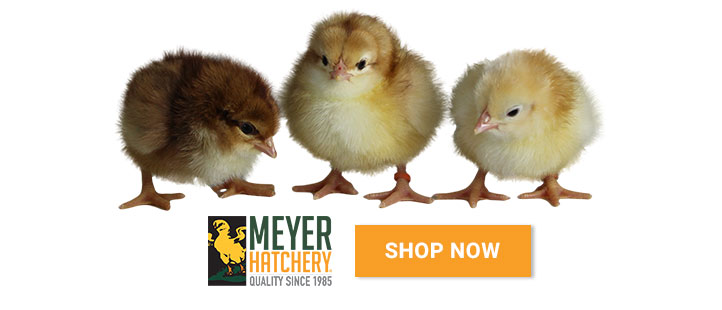Bringing home any pet is an exciting time for the whole family. But just like any other animal, rabbits require your full dedication and the right tools to make sure that they get off to a great start and live happy and fulfilled lives! So, to help you out, here is our new rabbit checklist, so that you can cross off everything you’ll be needing for your new furry addition.
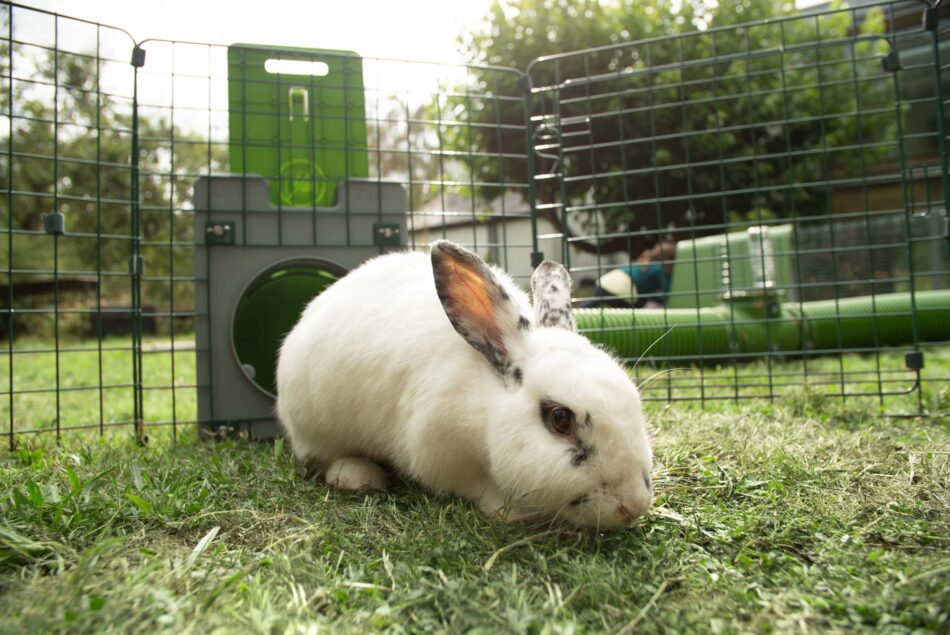
Hay/Bedding – A Must for Your New Rabbit Checklist
A great place to begin before getting your new pet rabbit is by making sure you have plenty of rabbit hay/bedding. Not only is fresh hay an important part of a rabbit’s diet, but they also require plenty for their bedding. Omlet’s own Eglu Go Rabbit Hutch also ensures that your new pet gets the comfiest night’s sleep!
Hay is also ideal for encouraging a rabbit’s natural instinct to forage, whereby in the wild, they would search for wild food sources. Foraging also helps to keep rabbits mentally stimulated. You’ll find that a rabbit who is only fed pellets from their food dish, as opposed to a balanced diet including hay, can end up eating too quickly, which can, in turn, make them unwell. Furthermore, a balanced diet for your rabbits will keep their teeth in good condition as well!
Rabbit Food and Bowls
A rabbit’s diet should consist of dry food, fresh food, and hay. Offering nutritious and balanced options is key so that you can pick the right food to suit the needs of your new pet rabbit.
Most rabbits love fruit and vegetables, so it’s a good idea to include these in their diet too. While you might associate rabbits with gnawing away at carrots, this type of vegetable can actually cause constipation in rabbits and make sugar levels rise dangerously if over consumed. The Caddi Rabbit Treat Holder is the perfect way to feed your rabbits fruit and veggies. Not only will it provide your bunny with entertainment but will benefit you too by improving run cleanliness and reducing food waste. So, if you plan on feeding your rabbit with nature’s very own treats, make sure to read our previous blog Which Fruit and Vegetables Can I Feed my Rabbit? where you can find a list of the fruits and vegetables that are suitable for your furry friend to be fed.
As well as food and an unlimited supply of fresh water, you should also make sure that your rabbit has a food dish alongside either a water bottle or water bowl. Some owners opt to use a bottle over a bowl, but this really is your decision to make. While bowls can easily get knocked over and wet your rabbit’s bedding, they are more of a natural way for a rabbit to drink. This being said, a water bottle reduces water waste and is usually better than a bowl when it comes to keeping your rabbit’s water supply at the same temperature.
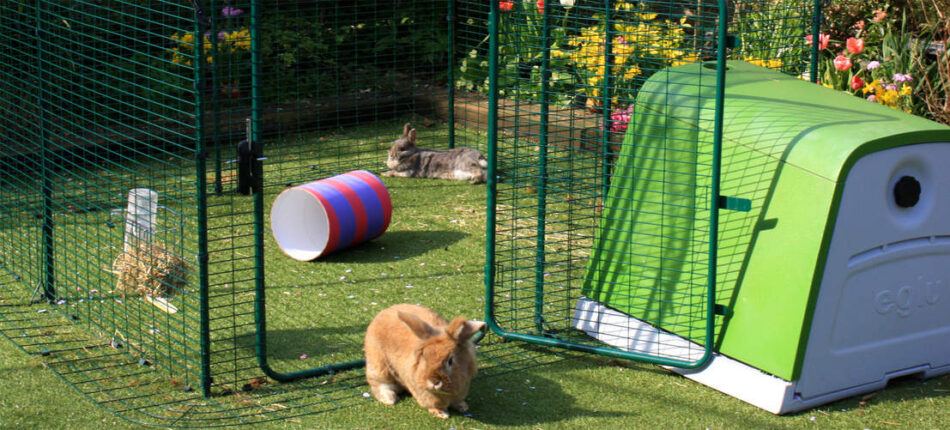
Rabbit Treats
While rabbits need to be fed a healthy diet, the occasional treat won’t go amiss! Treats are a great way of rewarding your rabbit. Your new pet rabbit will also absolutely love a little afternoon snack from their doting owner.
A Rabbit Hutch That’ll Last
Your new rabbit will of course need somewhere to live! Add the Eglu Go Rabbit Hutch to your new rabbit checklist – ideal for any prospective rabbit owner and will keep your bunnies safe from the outside elements and any predators. Even better, the Eglu Go Rabbit Hutch comes with a hay rack, feed bowl and water bottle, making keeping rabbits hassle-free! Furthermore, the Eglu Go Rabbit Hutch has a removable bedding tray, which means you won’t have to purchase a removable litter box for cleaning up after your pet.
If you opt to have a house rabbit, you’ll need to make sure that wherever they stay, they are in a bunny proofed room. You’ll find it helpful to read our guide on How To Rabbit-Proof Your House for some more information on this topic.
New Rabbit Checklist Essential: A Safe and Secure Run!
As well as your rabbits having a hutch or home to live in, they’ll also require a safe and secure run to provide them with some extra freedom and time for hopping around, so this definitely should not be missed off of your new rabbit checklist! One of the leading causes as to why rabbits dig, therefore potentially escaping from their run, is because of boredom. We wrote about this topic on our previous blog Rabbits and Digging if you’d like to find out more information on this area.
Fortunately, the Omlet Walk in Rabbit Run not only offers plenty of room for your rabbit to hop to its heart’s content but will also keep them secure and safe from any other pets or predators. The run has a stable style door, which means that the top and bottom of the door open independently so that you can throw in some treats for your rabbits without the worry of them making an escape! Alternatively, you can create the ultimate rabbit adventure playground with the Omlet Zippi Rabbit Playpen, which can connect to their run and hutch for more space.
Within your rabbit’s run, you’ll want to provide them with plenty of stimulation. Omlet has everything you need to keep your rabbits bouncing around with joy, from the Zippi Playtunnel designed to mimic a rabbit burrow in the wild, to Zippi Rabbit Platforms, that will provide you rabbit new places to explore!
Rabbit Toys
Something else to tick off your new rabbit checklist is toys! Just like our other pets, rabbits need to play, which means they’ll need plenty of toys to enrich their environment and keep their minds ticking! The Omlet Zippi Rabbit Tunnel System connects your rabbit’s run to their hutch but also doubles as a fantastic toy that your rabbit will love. You can also opt for hanging toys that can be attached to your rabbit’s run.
Somewhere to Hide
Your new rabbit will also need somewhere to hide. Although it might sound odd, rabbits actually have a natural instinct to hide in order to stay protected. In the wild, this is done so that they can keep safe from predators such as foxes. Hiding is also a rabbit’s natural response to fear, if they feel stressed, are in pain, are unwell, or just want a break from social contact! Omlet’s Rabbit Zippi Shelter is ideal for rabbits to carry out this behavior, providing them with a safe space where they can retreat to relax.
Nail Clippers
A rabbit’s nails should not go neglected, so you’ll need to make sure you have nail clippers at the ready! In fact, nail clipping is an essential part of rabbit care, and you’ll need to do so approximately once every two months due to the remarkably quick rate they grow at.
While nail clipping isn’t too long of a process, if you’re not confident doing so, you can always make a visit to the vet, and they will be able to give you a helping hand.
New Rabbit Checklist Conclusion
So, whether you’re getting a new baby bunny or rescuing an adult rabbit, hopefully, you will now be prepared for what is to come when your new pet arrives home!
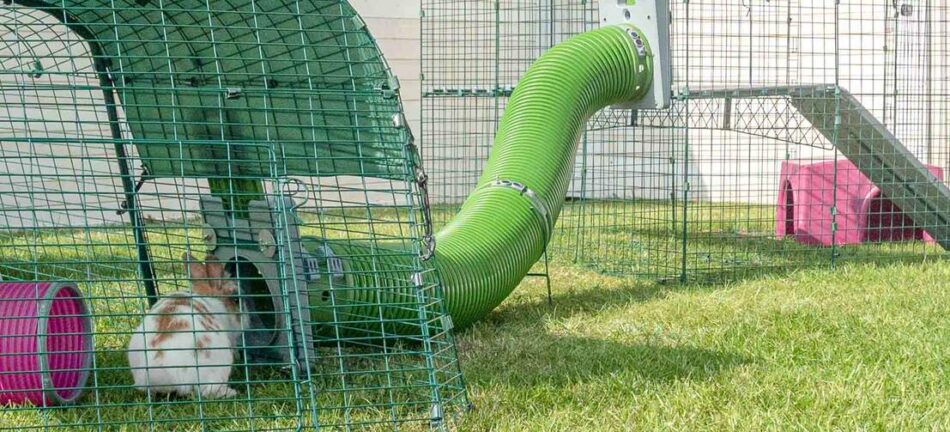
This entry was posted in Rabbits
We all know that dogs have been man’s best friend for centuries, but have you ever thought about friendship with a pet rabbit? Just like dogs, rabbits are highly social animals. This means that they enjoy the company of others, be it of their own species or ours! In fact, evidence even suggests that rabbits who bond with their owners live longer and happier lives! With so much love to give, these sweet natured, fluffy creatures can make for the perfect pets. So, could rabbits be your new best friends?
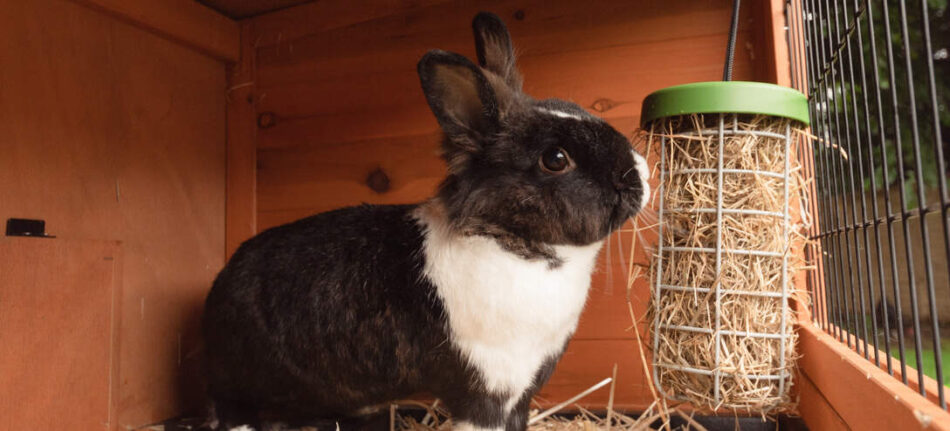
Why Should I Get a Rabbit?
First and foremost, rabbits are very loving pets and will show their owners affection in a number of ways. So, rest assured, you could be on your way to becoming your rabbit’s bestie in no time! If you’re considering getting a rabbit, you’ll grow to learn his or her specific body language. However, generally speaking, a rabbit that loves their owner will display this by purring, running around your feet, or even grooming you!
Putting aside just how irresistibly cute these animals are of course, they’re also incredibly amusing and will provide you with plenty of entertainment. So that your rabbits can become your new best friends, they need plenty of play time with you! Rabbits love playing with a wide array of rabbit toys, which not only helps them keep active, but will provide them with plenty of mental stimulation. And after a hard day’s work of hopping around, you can treat them to a few tasty rabbit treats – the perfect bonding experience!
Rabbits are also particularly appealing to those who would like a furry friend in their life but might not be ready to take on a cat or a dog just yet, that need that extra bit of time being walked or trained. This being said, rabbits still very much require your full dedication as an owner.
What To Consider Before Getting Rabbits
As with taking on the responsibility of any pet, you need to consider whether a rabbit could fit into your lifestyle. Rabbits might not require as much time or training as say a dog would. However, they still do desire companionship and stimulation to live the happy, fulfilled lives they deserve.
Something to consider before getting rabbits is your family dynamic. Although rabbits are commonly associated with being ‘starter pets’, they’re not suitable for young children in some circumstances. This is predominantly for the reason that many rabbits are naturally nervous and don’t like being handled. If your rabbit does have to be picked up, it should be done very gently, which unfortunately doesn’t often go hand in hand with very young children! This being said, some breeds are known to get along well with younger members of the family. The French Lops for example love socializing and won’t mind being handled.
Could Rabbits Be Your Pets’ New Best Friends?
If you’ve also got other pets, this will be something else to think about before bringing home your new addition. Fortunately, many of our other favorite pets do have the ability to get along with rabbits. However, this isn’t to say you should simply put your pets in one room at the same time and leave them be! Instead, slowly introduce your animals in a neutral space, with a barrier such as a crate or fence.
If you’re introducing your rabbit to your dog, keep your dog on a lead at all times. Regardless of whether you’re introducing your rabbit to a cat, dog, or chicken, you should never leave them unsupervised during this stage. Keep a close eye on their interaction. You should watch out for whether your rabbit or other fluffy friend acts in an aggressive manner or seems anxious. You can read more about keeping rabbits and chickens together on our previous blog. Please note that rabbits should not be kept with other small animals such as rats or guinea pigs.
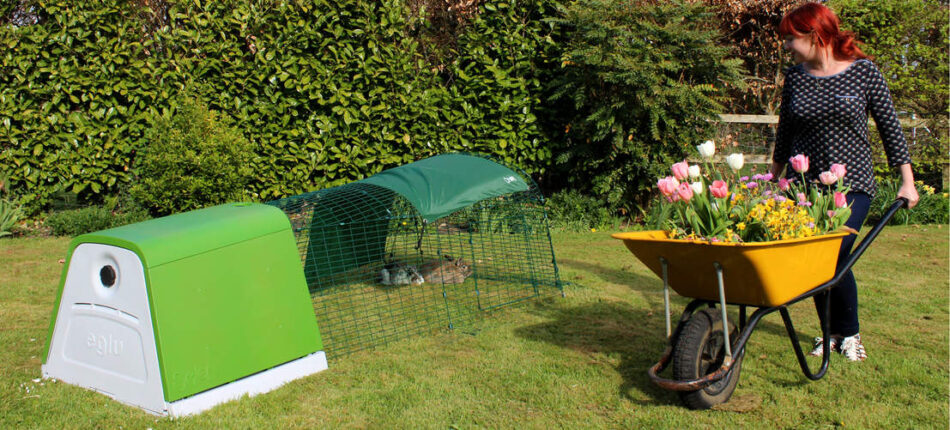
Where to Get Rabbits
As with getting any animal, it’s important that rabbits are purchased/rescued from a reputable breeder or center. Take time to do thorough research. Some rabbit breeds are better suited to owners with a little bit more experience than others.
Because of the misconception that rabbits are ‘easy pets’, there has been a surge in unwanted rabbits in shelters. The House Rabbit Society headquartered in Richmond, California. They ask that those interested in rabbit ownership consider fostering for a short period of time. This is so they can ensure that rabbits are being properly taken care of. It’s also so that prospective owners can see if a rabbit will suit your lifestyle before making the commitment. To find more information about the House Rabbit Society, visit their website at Our Programs | House Rabbit Society
If you’re unsure of where to start when it comes to picking what rabbit breed would be best suited to you, take a look at our a-z Rabbit Breed Guide. Once you’ve narrowed your options down, have a read of our How to Choose the Right Rabbit Breed for You blog, so that you can find your match and new best friend! So, could rabbits be your new best friends?
This entry was posted in Rabbits
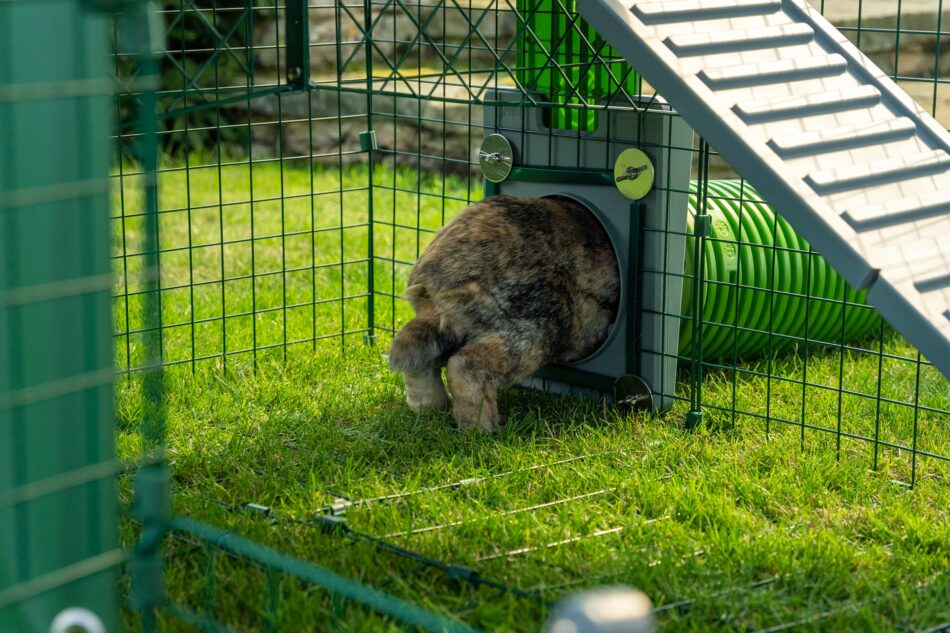
Most people would associate rabbits with carrots, but in reality rabbits and digging go hand in hand. No matter the variety, all rabbits have an innate desire to burrow, tunnel, or scratch in the dirt. But is it out of boredom, fun or just general mischief? Look into the behaviors of our long-eared friends with us, and delve deeper down the rabbit hole to discover why they dig. And, there are some simple Omlet-approved hacks that might just do the trick in helping to curb your bunnies’ burrowing habits.
In the wild
Wild rabbits live in burrows – a network of underground warrens where they feel safe and protected from predators such as foxes and dogs. Digging is a necessity; a matter of survival. Without it, they would be left open to attacks, which is why rabbits have evolved into the tiny excavators that they are today.
Have you ever noticed just how big a rabbit’s paws are? All the better for pounding away at the dirt. And, their long claws are perfect for scraping at the earth. Maintaining their warrens is a big job – requiring these specific tools nature has provided them with.
All rabbits have their own behaviors and personalities, but females tend to be the most determined diggers because they instinctively prepare themselves for nesting. These traits carry over into our domesticated pet bunnies as well.
Fun and exercise
Digging is not just instinctive though, it is an engaging activity that’s also great exercise (think Zumba for rabbits). So rather than trying to eliminate it completely, it’s a good idea to give pet rabbits ways they can utilize this natural behavior without destroying areas of your home or yard. At Omlet, we’ve developed the Zippi Rabbit Tunnel System, so that our pet bunnies can feel at home and comfortable – all while keeping your garden intact. Rabbit proofing your garden can also help give your bunny space while protecting your prized plants. Zippi tunnels provide an extensive playground of interconnecting tubes that keep rabbits entertained, similar to the burrows their wild ancestors would be used to. It also provides a safe route for your rabbits to navigate from their hutch, to their area, and back again. This method of travel mimics how rabbits in the wild utilize tunnels and burrows between warrens and the outside world.
Change the course of the Zippi tunnels anytime. The tunnels can be extended, rotated, or elevated for a more diverse route. An engaged bunny is a happy bunny, as boredom takes a toll on all rabbits.
Boredom
Constant digging not only wreaks havoc and poses an area of concern to you, but it could also be a sign that your rabbit is bored or lonely. Bunnies are naturally very sociable animals that love company. We strongly recommend giving your rabbit a housemate or two, because they thrive best in a pair or group setting.
If you do only have one rabbit then they will need more attention and entertainment than those who live with other bunnies. Sometimes rabbits can create a strong bond with their owners that is enough to curb any loneliness. Or, other playmates can include guinea pigs, small dogs, or cats – but these are largely dependent on the animals’ individual personalities. Any mixed-species interactions should be monitored closely.
Always offer plenty of enrichment for your rabbits. A Caddi Rabbit Treat Holder will help keep them entertained during snack time. Some rabbits also enjoy small toys like those designed for cats, or those specially made for rabbits.
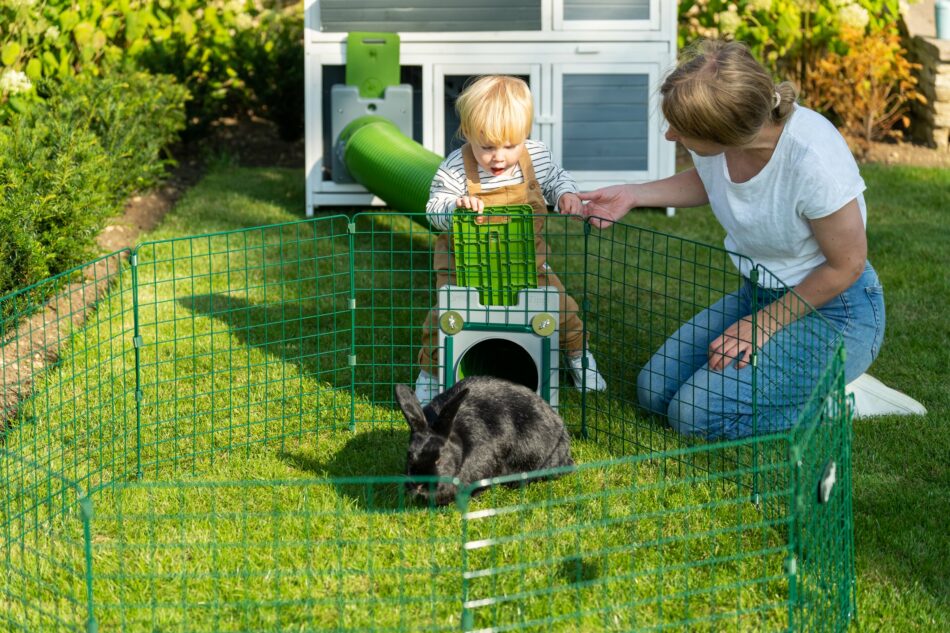
Space to explore
If you start to notice some aggressive and disruptive behavior in your rabbits, it could be due to a lack of space. Even as small animals, they can outgrow their living quarters. Rabbits will thrive much more with space and stimulation. The Zippi Rabbit Runs and Playpens provide your rabbits with more room to grow and explore in a safe environment. They’re simple to install, move, and maintain. They’re also easily extendable, offering endless possibilities and fun. Add Zippi Rabbit Platforms to utilize even more space and provide different vantage points.
5 ways to curb your rabbits’ digging
The more idle rabbits are, the more trouble they will cause. Keeping busy generally results in less digging from your rabbits. Provide lots to do to keep your rabbits busy. Here are 5 ways to help your rabbits dig safely, or to discourage digging altogether.
1. Digging boxes
Place a cardboard or plastic box in your rabbits’ area and fill it with soil, paper, twigs, or anything else that will provide a little resistance. Your rabbits can satisfy their urge to dig while also burning some excess energy in the process.
2. Reward
Scatter your rabbits’ favorite treats around a designated “digging spot” to reward their burrowing efforts, and hopefully prevent them from digging elsewhere. It may take some patience and consistency, but over time, they should get used to the new routine.
3. Organizing
Indoor and outdoor rabbits enjoy organizing. They may not color-coordinate their closets, but they do like to pull, bite, tug and scratch the materials around them. This is called “bunching”. Not only is this a great source of entertainment, it also keeps them physically and mentally busy. Use some old bath mats, rugs or towels and let them “bunch” as much as they want – which will effectively provide a good distraction from creating a hole in your flowerbed. Be careful with the type of fabric – if anything shreds too easily it could become a choking hazard, so be sure to change the fabric if it becomes too thin or worn.
4. Spaying or neutering
Some rabbits will dig out of frustration and the need to escape and find a mate. Spaying or neutering your rabbits will diminish this impulse and prevent other unwanted behaviors. Like with dogs and cats, in the long run, your rabbits will be healthier and happier being spayed or neutered.
5. Anti-tunnel mesh
The Omlet Eglu Go Rabbit Hutch attached run, is made from a strong steel mesh that helps protect your rabbits from predators. It also comes with an underfloor wire that will not only keep your rabbits from their relentless digging, but will also help stop them from burrowing under the run and escaping. It’s more hygienic than a solid floor, with big enough gaps in the mesh so that it still provides the comfort of grass rather than uncomfortable hard ground or metal.
Omlet: the rabbit behaviorists
At Omlet, we dedicate our time to developing products with the animal and their owners in mind. Our Caddi Rabbit Treat Holder, Zippi Rabbit Tunnel System, and Zippi Rabbit Runs and Platforms are all perfect additions to any bunny-lover’s home, and will help keep your rabbits healthy and happy for years to come.

This entry was posted in Pets
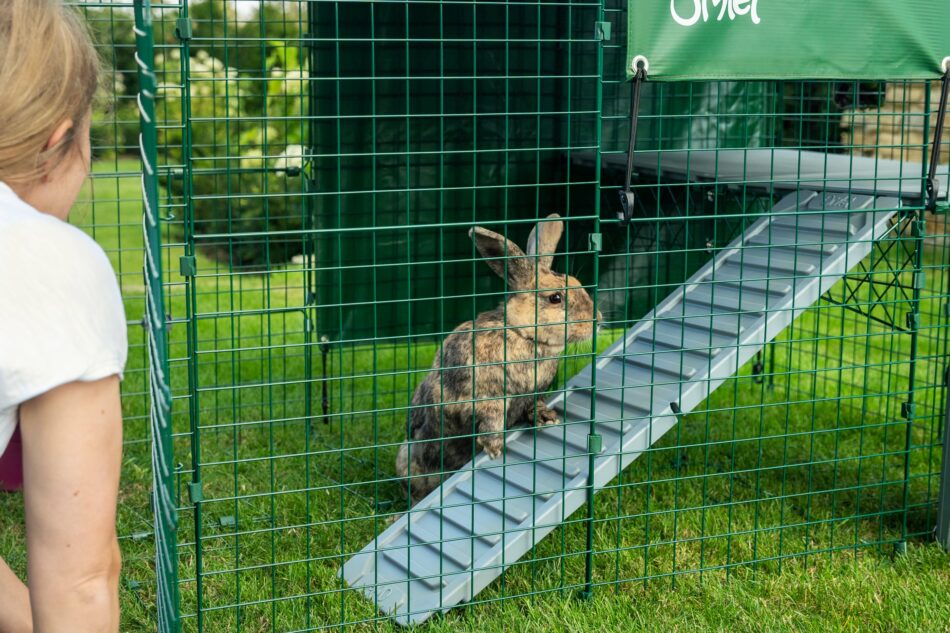
Compared to a one-level play area, having an additional floor height in your rabbits’ enclosure boosts exercise opportunities, helping your rabbit activate muscles that they would use in their natural environment to climb up and down underground mazes and burrows. Jumping on and off a platform helps to keep muscles and bones strong, which is why platforms are recommended as an essential rabbit accessory by vets and pet charities. So how do you use Omlet’s Zippi Platforms with your rabbits?
What are the Zippi Platforms from Omlet?
The Zippi Rabbit Runs and Platforms from Omlet are designed to offer a modular system that you can adapt at any time. The platforms fit securely to the Zippi rabbit enclosure, so they feel safe underfoot and are waterproof so they’re easy to clean with just a garden hose and pet-safe disinfectant. Start small, and add more extensions and platforms at any time to build an amazing play area for your rabbits.
How can I give my rabbits more space?
Platforms are also an easy way of giving your rabbits more space to move around and explore. By positioning a platform in your rabbit’s enclosure, you can make better use of the height to give an even bigger area for toys and exercise. The platform gives a look out for rabbits to examine their environment from a height, plus a more exhilarating way to exercise. The area beneath feels safe for rabbits to relax and graze on hay, or if they need to shelter from bad weather.
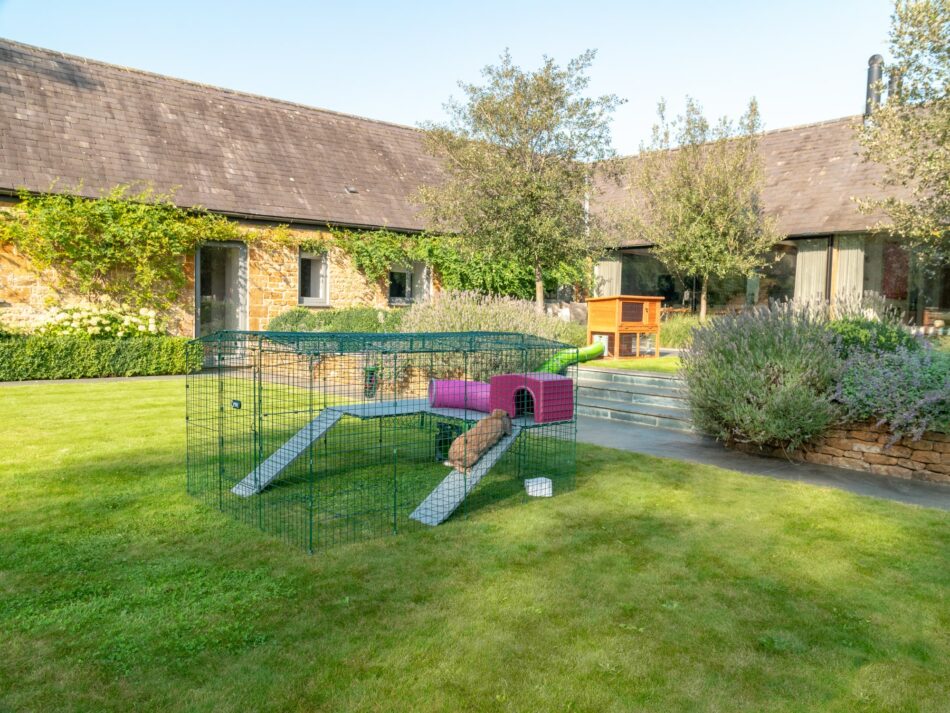
5 ways to use the Zippi Rabbit Platforms
Need some inspiration on how you can use platforms with your pet? Take a look at our ideas below to create a fun and safe area for your rabbits to exercise.
1. Take shelter to new heights
The Zippi Platforms offer shelter below for bad weather days, but your rabbits can still make the most of the second level in their enclosure during wind and rain, with the Zippi Shelters and Play Tunnels.
With a 3-panel wide rabbit platform, you can even position a Zippi Shelter at either end and connect them together with a Play Tunnel. Or position one Shelter on the platform and one below. Don’t forget to pop some hay inside the Shelter on the platform so your rabbits can nibble away on a snack while they wait for the storm to pass.
2. L-shape suite
The Zippi Corner Platform for rabbits with a multi-panel platform pack can be used to create an L shaped mezzanine area with 2 ramps. Depending on the length and width of your Zippi enclosure you can either position both ramps in the same direction or create a slight spiral effect.
Here we have used a Corner Platform for rabbits, attached to a Zippi Platforms 3-panel pack, in a 3 x 3 double-height Zippi Run.
3. Down and straight back up!
In a longer Zippi run, around 4 or 5 panels in length, you can position Zippi Platforms opposite each other so your rabbits can run straight down one ramp, and back up another for a loop-the-loop circuit. Don’t forget the Zippi Platforms are strong and sturdy so your rabbit will feel safe to jump and hop up and down the ramp.
4. Lunch on the balcony, sir?
Position Caddi Treat Holders to hang over the platforms so your rabbits can enjoy their lunch with a garden view. Mix up the ingredients in the slow-release feeder to keep rabbits excited, and ensure a 5-star rating for your new bunny bar! These feed toys can also be used as a hay rack to keep the floor of your rabbits’ house or play area clean.
5. Zippi Tunnel to the first floor
Combine the Zippi Platforms with our popular Zippi Rabbit Tunnel System by positioning your Zippi Tunnel entrance up on the platform level. This means your rabbits can hop up and down the Zippi Tunnel to get from one enclosure to their platforms, down the ramp and into another Zippi Run.
You can use the Zippi Platforms with a Zippi Tunnel Twin Pack with Hutch to Run Connection Kit and Zippi Tunnel Supports to connect a Zippi Run and an Eglu Go Hutch Run. Alternatively, you can connect the tunnels to your wooden rabbit house to another enclosure.
Omlet and your rabbits’ home
As a rabbit owner, it’s your responsibility to provide your rabbits with everything they need, and that includes a safe enclosure, where they can play, exercise, eat, and clean themselves. Providing a range of toys for play and exercise will help keep your rabbit happy and healthy, and with Omlet’s Zippi Platforms along with the Zippi Rabbit Tunnel System and Eglu Go rabbit hutch you can do just that, with a playground they’ll love.
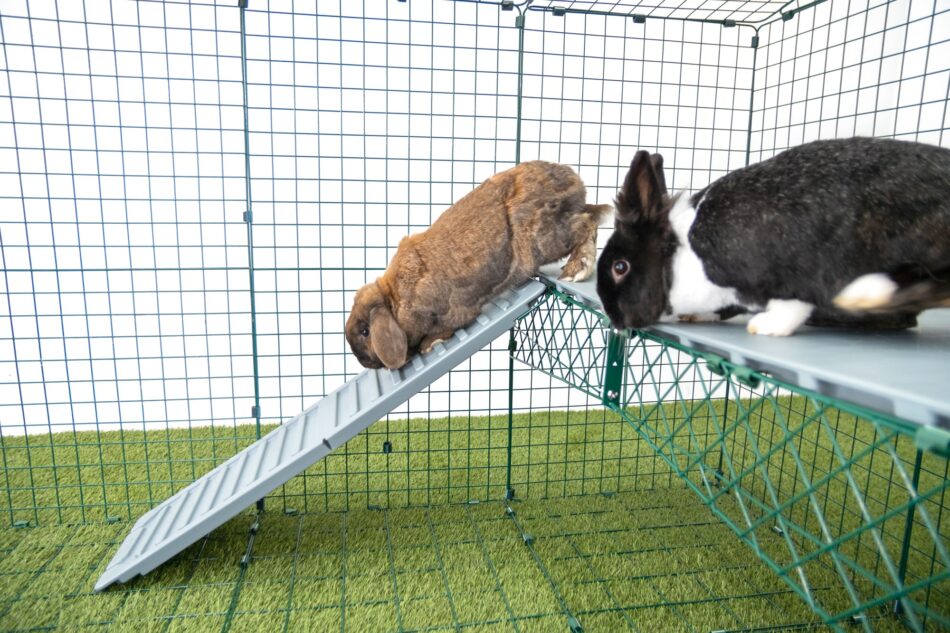

This entry was posted in Rabbits

Whether you’re buying a present for an animal loving child or for your own little pet, we’ve got the perfect gifts, big and small. Check out these top tips, now at an amazing price in the Omlet Black Friday Sale!
Shelters and Play Tunnels
Give your rabbits or guinea pigs something fun to play with on their run this winter with Zippi Shelters and Play Tunnels. Available in green or purple, the shelters are a great way of providing a safe and secluded place for your pets to hide, or as a platform they can jump onto and watch the world go by.
The play tunnels can be placed independently anywhere on the run for your pets to chase each other through, or be connected to the shelters to create a maze that mimics their wild burrows. Entertainment and safe spot all in one!
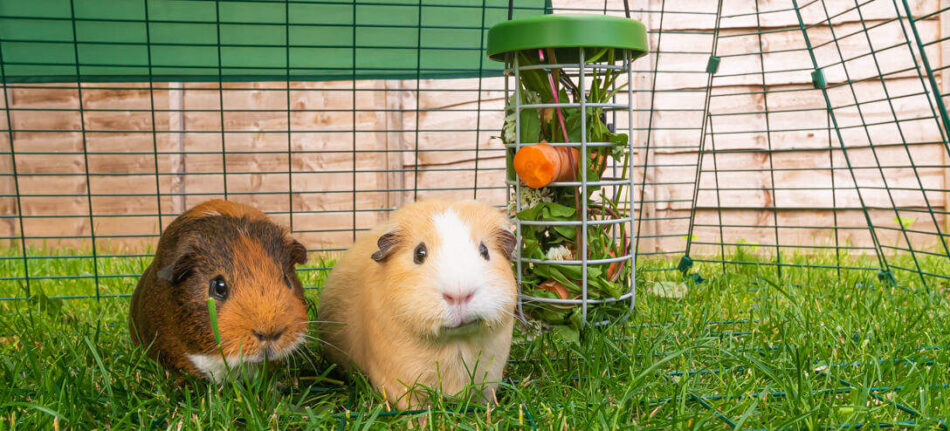
Caddi
The Caddi Treat Holder is the perfect stocking stuffer for chickens, rabbits or guinea pigs, or their owners. The Caddi can be filled with a range of pet appropriate treats, and will swing as the animals peck or bite the treats. It’s the ideal both mental and physical challenge, with the added bonus of a tasty reward!
Hung from the roof of your hutch and run, the height of the Caddi can easily be adjusted, and it’s super easy to remove it for refilling and cleaning.
Qute Hamster and Gerbil Cage
The Qute allows hamster and gerbil owners to get closer to their pets. The modern design means you will be happy to display the piece in your kitchen or living room, and the large, crystal clear bedding tray makes it easy for pet owners of all ages to see what their pets are up to. The bedding tray also offers a convenient way of getting your hamster or gerbils out of the cage for playing, socializing and exercise.
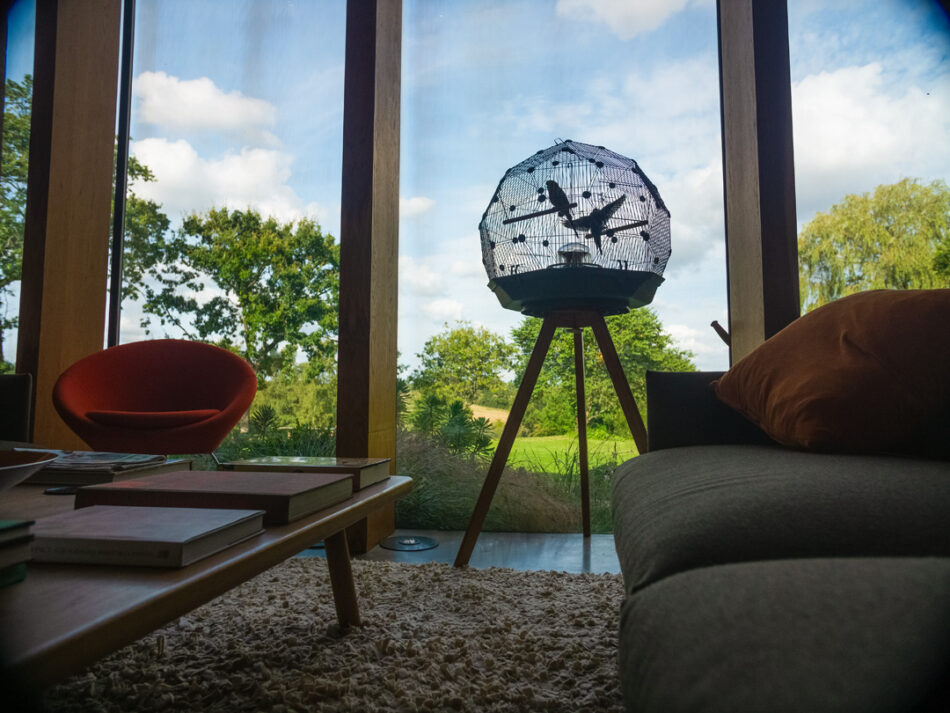
Geo Bird Cage
Upgrade your parakeet/budgie or other small birds’ home this winter with the stunning Geo Bird Cage. The Geo has got everything your bird needs to become a natural part of the home, and you can accessorize with baths, mirrors and toys for your pets to enjoy.
Eglu Go Hutch
Do your current pets need a home improvement? The Eglu Go Hutch is the perfect way of keeping rabbits or guinea pigs in the garden. The handy integrated hutch and run solution allows your pets to run in and out as and when they like during the day, and when it’s time for a nap they can curl up in the safe and insulated house. In winter you can move the hutch closer to the house, making cleaning and spending time with your pets even easier.
This entry was posted in Birds
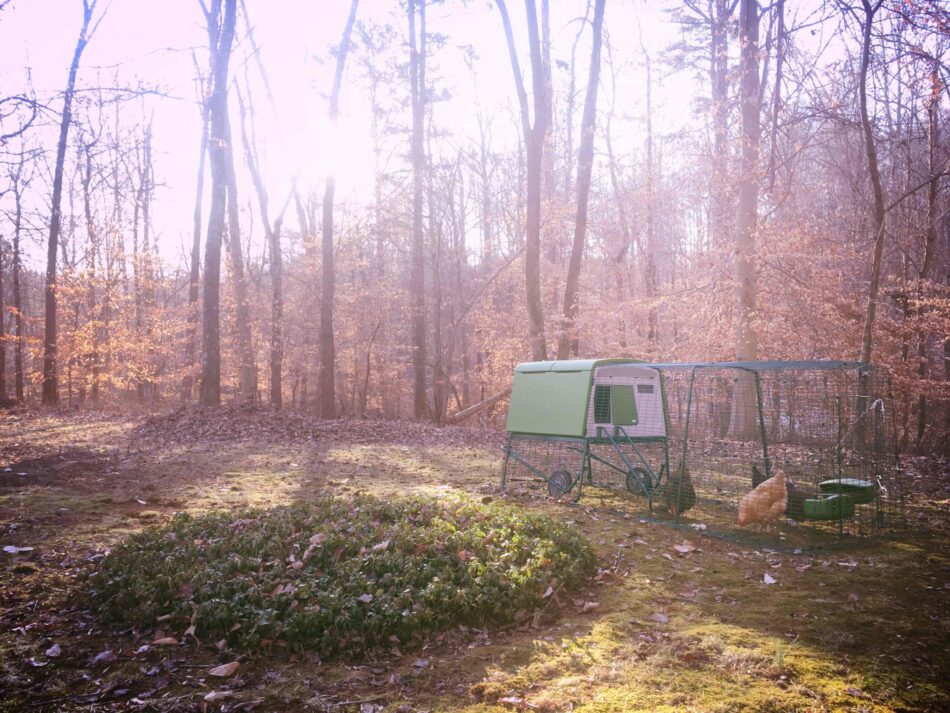
It’s that time of year again when we say goodbye to summer and welcome in the cooler, shorter fall days. For many pet owners, summer is a great opportunity to spend quality time with their animals; playing outdoors and enjoying the warmer weather. But, the change in season doesn’t have to mean that the good times have to stop. So whether you’ve got a chicken, guinea pig or are a pet parent to rabbits, here are 8 tips for making their run more fun this fall.
Why do pets need runs?
It’s important that you continue to keep your pets exercised throughout the year, and animal runs are great for this, giving your furry friends the freedom to roam within a safe and confined environment. Omlet has a range of runs for chickens, rabbit runs and guinea pig runs, which are all predator-resistant, with their innovative mesh designs.
Whilst runs are fantastic for providing your animals with more space, adding a few extras over the next coming months can help to keep both you and your pets entertained.
For guinea pig and rabbit runs
Pig out on veggies
Cavies and rabbits love their fresh veg – you can even make a game of it! Try hiding their favorite pieces of veggies around the run and have them go off to find their treats. This game is the perfect opportunity for you to spend some quality time outside with your pet. Just don’t forget to clean up any remains from the run floor to avoid pesky predators sniffing out the snacks.
Or, use the Omlet Caddi rabbit treat holder or guinea pig treat holder to keep your pets’ brains engaged. Simply fill the treat holders with your rabbit or guinea pig-safe vegetables and watch them spend time navigating how to get them out. Take a look at some suggestions for rabbit treats and guinea pig treats here.
DIY adventure playground
Upgrade your pets’ run to an adventure playground with pet play tunnels. They can simply be attached to your guinea pig or rabbits’ run and provide them with a new way to exercise. Plus, they’ve been designed to mimic the innate burrowing behaviors of rabbits and guinea pigs too.
Shelters can also be a great addition to your run this season. The Omlet Zippi Shelters for rabbits and Zippi Shelters for guinea pigs are weatherproof too, meaning that your pet will be protected from the elements in fall.
And since both pets have a natural desire to seek a hiding space in a hole, you can be assured that while they’re having fun, they’re feeling safe. The Zippi shelters easily attach to the Omlet play tunnels via connector rings, too, which means you can create a fun maze for your furry friends.
Guinea pig and rabbit toys
Who said toys were just for cats and dogs? Give a new toy to your small animal to help to bust their boredom this season. Toys for guinea pigs and rabbits can simply be hung up in their run and will keep them active, engaged, and curious.
For chicken runs
Make use of those crisp, fall leaves
The leaves of fall in your backyard can actually be a great source of entertainment for your chickens. All you have to do is build up a pile of crisp fall leaves in your chickens’ run, and watch them have endless hours of fun pecking. You can even add some sunflower seeds to your pile to have your flock hunt for.
Omlet’s Chicken Swing
Omlet’s Chicken Swing is the perfect way to make your chickens’ run more fun this fall. The Omlet Chicken Swing will have your chicken in their element, as they get to grips with their new toy. Not only will this run accessory provide them with plenty of entertainment, but you’ll have just as much fun watching them hop on and off and swing back and forth.
Toys for chooks
Chickens can have toys too. A bored chicken can lead to behavior such as flock bullying and abnormal feather loss, so at this time of year it’s even more important to keep your chickens entertained. Naturally, as the weather drops, these animals get increasingly restless, with less grass and weeds for them to forage on, as they enjoyed over the summer. A chicken peck toy though, is one option to keep your flock happy, providing them with physical and mental stimulation.
Pumpkin run fun
It wouldn’t be fall without pumpkins! Simply place half a pumpkin in your chickens’ run for them to have as a special treat. Your flock will have no problems pecking at the pumpkin raw, so there’s no need for any cooking; just slice the top of the pumpkin off and then in half, to place outside in their run. Something to be cautious of here though, is to ensure that you remove any pumpkin remains from the run once finished to avoid any unwanted visitors such as rodents at night.
Omlet and your pets’ fall
Omlet knows that this time of year can be more difficult for pet owners but whatever the season brings this year, with Omlet’s range of guinea pig, rabbit and chicken products you and your pets can continue to have fun all fall long. And, as the end of the season brings colder weather, don’t forget to have a read of the Omlet guides on keeping your guinea pigs, rabbits, and chickens safe and warm when they’re outdoors.
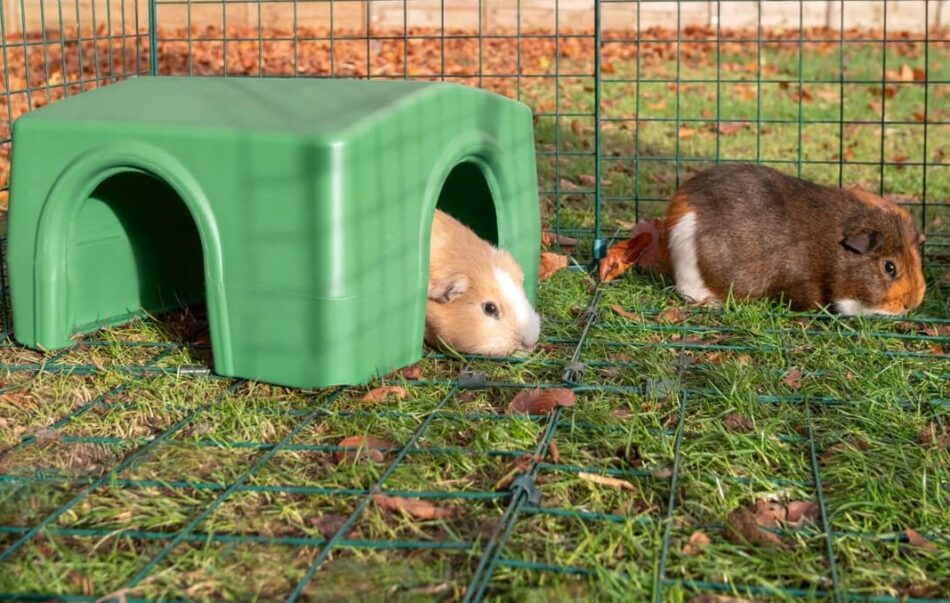
This entry was posted in Chickens
Photo by lilartsy on Unsplash
If you have done your research and decided that a rabbit is the pet for you, you now have the task ahead of choosing which rabbit breed you would like to get. There are lots of wonderful breeds to choose from, and they all have their own specific features and characteristics. To help you pick the right rabbit for you and your family, we’ve put together a list of things to think about:
Size
Rabbit breeds differ in size, from small Netherland Dwarfs to large Flemish Giants. Smaller breeds tend to be more skittish and nervous, whereas larger rabbits are generally more gentle and less aggressive.
Larger rabbits will naturally need more food, and more space. But don’t think that small rabbits will be fine with limited space, often littler bunnies run around a lot more as they have more energy.
Child-friendly rabbit breeds
While young children should never be given the main responsibility of looking after a rabbit, if you have children in the family it’s good to find a breed that is generally happy to be touched and handled.
A lot comes down to personality, but there are some breeds that are known to get along well with children, like French Lops and Dutch Rabbits.
Reason for getting a rabbit
Think about why you are getting a rabbit, and what is important to you in a pet. Are you happy to just watch them enjoy themselves in the garden, or would you really like to have a rabbit that is sociable and wants to come to you for cuddles? Would you like to breed for your bunny, or show it off in rabbit shows?
Looks
Rabbits come with various fur lengths, colours, ear types and builds. You probably have an idea of what you would like your pet rabbit to look like, but it’s worth exploring a few different breeds to see what’s out there.
It’s important to remember that different breeds require different amounts of grooming and looking after. Long fur, like that of the Angora rabbits, will for example need brushing daily or a few times a week, so you will need to consider if that is something you will be happy to do.
Meet the rabbit in person
While rabbit breeds have characteristic features and temperaments, a lot also comes down to breeding and personality. If possible, try to go and see the breeder or person you are buying your rabbit from, or the center where you’re adopting from.
If your rabbit is still small, watch how they interact with their surroundings and siblings, and if possible, see what the mother is like. Make sure the rabbit doesn’t have any obvious health problems, and try to get a feel for its temperament. If it’s important for you that the rabbit is happy to be picked up, make sure they have been around humans from the start and have regularly been handled.
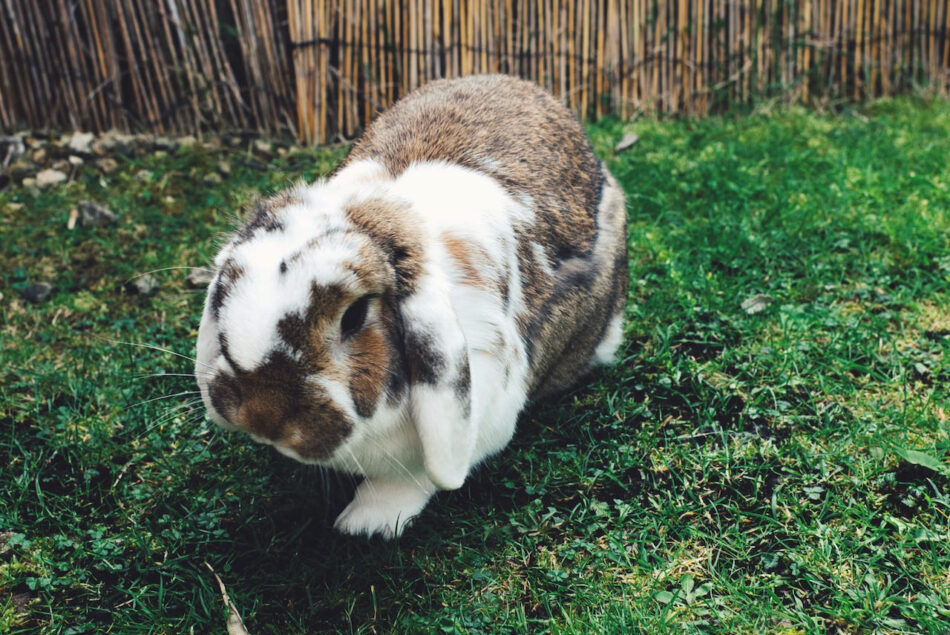
Photo by Cameron Barnes on Unsplash
Genetics
Read up on specific breeds’ susceptibility to different health problems. Some breeds tend to have a higher risk of developing problems with their jaws, others with joints, or ear mites. With good care the absolute majority of rabbits will be happy and healthy, but it’s a good idea to research problems in order to prevent them.
The expected lifespan also differs somewhat between breeds. The majority of rabbits live between 5-8 years, but some breeds are known to often live for over 10 years. This is obviously a bigger commitment, so it’s worth thinking about.
Consider these things when choosing a pet rabbit. If you know what you want, here are some of our suggestions:
You want a gentle family bunny that is good with children
You have had rabbits before and want something special
You want to keep your pet rabbit indoors
You want an intelligent rabbit that is very energetic and playful
You want a really fluffy and cuddly rabbit
This entry was posted in Pets
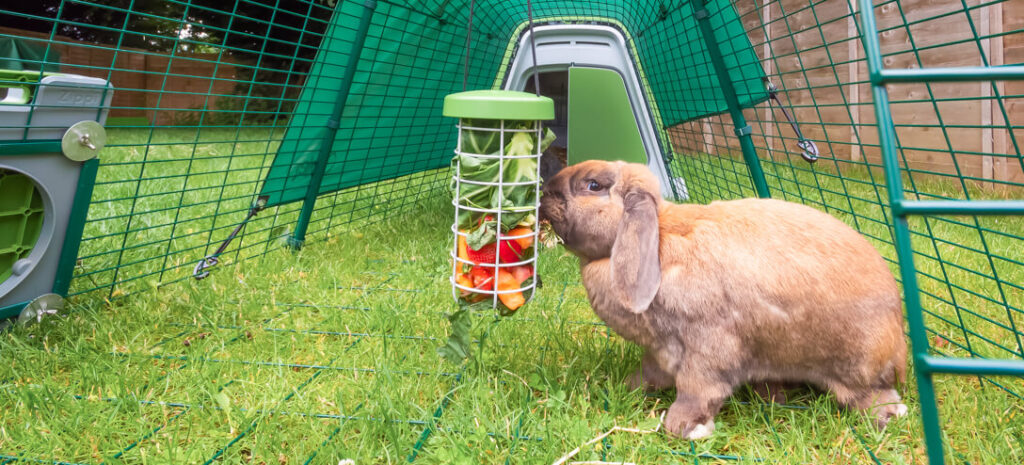
Estimates of the world’s domestic rabbit population vary wildly between 15 million and over 700 million. People have kept rabbits for hundreds of years, and traditionally they were farmed as a plentiful resource – after all, they do breed like rabbits! The larger population estimate includes all the rabbits that are still kept for meat and fur.
With this many rabbit owners around the world, and with the bunny’s rather inscrutable facial expression, it comes as no surprise that the question “is my rabbit happy?” has been asked more than a few times by anxious rabbit keepers.
There are several ways of telling whether your furry friend is content and happy, most of them centering on body language.
Happy bunny body language
Body language is the key way of telling how your rabbit is feeling. Simply by spending time with your bunny, you will learn some of the basic messages that tell you if they are happy and relaxed, or stressed.
These are some of the signs of a rabbit’s mood.
- Twitching nose. Rabbits are constantly twitching their noses. Not only does this help them sniff the air around them, it also eases their breathing, regulates their body temperature and helps them relax. A contented rabbit will do a lot more nose-twitching than a stressed rabbit, so if you notice that your rabbit hasn’t twitched its nose in a while, there may be something distressing it.
- Chilling out. Another easy-to-spot sign of a happy rabbit is an overall relaxed body. Chilled bunnies will lie quietly, ears erect (unless their flop-eared bunnies), sometimes with their legs stretched out, noses twitching contentedly.
- Crouching. Like us, when a rabbit is stressed, its muscles become tense as its fight-or-flight instincts activate and its body floods with adrenaline. If the bunny is in a crouching position, ears flat, pupils dilated, it is anxious, stressed or afraid. The cause could be another pet, a scary noise, or even a whiff of something unfamiliar in the air. This behavior is common in rabbits who have not been hand-tamed from a young age. Alternatively, if your rabbit is chilled out, lounging in the hay and not tensed up in any way, you can be sure that they are content.
- Hopping. When most people picture a rabbit, they imagine a cute creature hopping around. Rabbits have evolved to be great jumpers, with very strong back legs to help propel them at high speeds. Hopping not only acts as a great escape mechanism, it also assists rabbits in their play. Bunnies like to hop around when they are feeling happy and mischievous. Your rabbits may perform the occasional playful leap in their enclosures, jumping in the air, twisting their bodies a little and then landing again, alert and playful. A rabbit showing this type of behavior is very happy with life. A bunny who is gently hopping around and exploring the world around them is also feeling playful and happy.
- Running. A rabbit who darts for cover, usually stamping its back legs on the ground first, is not a happy bunny. Something has startled your poor pet, and the best thing to do is let it recover its composure and confidence in a safe area – usually a quiet corner of the hutch. A quick run to another spot, with ears flat, can also be a sign of anger.
- Curiosity. Rabbits are naturally nervous and will only let their curiosity take the lead when they feel safe. In the wild, rabbits are at the bottom of the food chain, a source of food for many predators. Because of this, rabbits are naturally jumpy (pun intended) and on edge. Domestic rabbits are calmer than their wild relatives but still retain their natural wariness.
Angry bunny body language
These physical clues tell you that your bunny isn’t chilled or afraid – it’s hopping mad!
- Sitting, front legs raised. If your rabbit sits up, front paws raised and flicking in and out as if trying to punch something, it means the bunny is angry – no matter how cute the behavior might look! The ears will be erect (although not in flop-eared bunnies) and facing outwards like radars. The posture may be accompanied by a growling sound.
- Crouching and thumping. If your rabbit is tensed up and thumps its back legs on the ground but doesn’t bolt for cover, it’s angry. The tail will be raised and, in stiff-eared breeds, the ears will be erect. Everything about the bunny will look tensed up, and the pupils will be dilated.
- Crouching with bared teeth. If your bunny is crouched with its front legs stretched in front of it and its head up, teeth bared, it’s angry and ready for a fight. The body will be tense, even quivering, and the mouth will be open, the tail raised, pupils dilated and ears folded back.
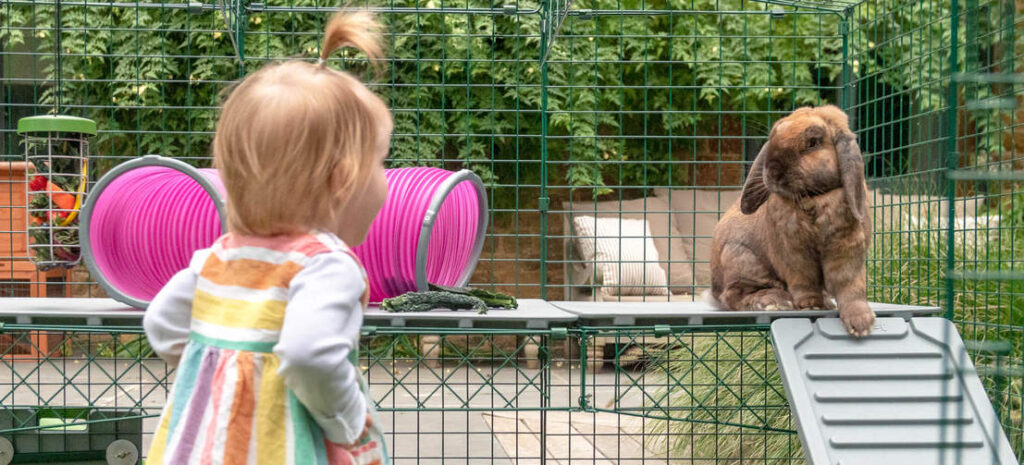
How to make rabbits happy
There are various reasons why a pet bunny might be unhappy or stressed. The commonest cause is poor environment. They need sufficient space in their hutch and run, and they don’t want to be harassed by nosy dogs, cats or loud parties. The rabbits will also need the company and stimulation that enables them to fulfill their natural instincts. Remember – rabbits are social animals and love having other bunnies to play with.
Giving your rabbits regular health check-ups and ensuring they are up to date with their vaccinations is also essential. A healthy diet will go a long way towards ensuring a happy bunny. A high-quality pellet mix and a lot of hay form the basis of healthy diets, with fresh veg as treats.
To summarize, if your rabbit is relaxed around you or shows signs of curiosity rather than fear when introduced to something or someone new, they are almost certainly happy and relaxed.
A chilled-out rabbit is a mixture of nature and nurture. They are naturally skittish animals, but if handled by their owners at an early age, they will come to treat you as part of their safe environment, and their happiness will be obvious in the fact that they love spending time with you.
This entry was posted in Pets
Behind the twitching noses and soft expressions of rabbits lies a surprisingly structured social system. Because they’re social animals, bunnies thrive best when living in pairs or groups. But with more than one rabbit in the mix, you’ll quickly see a hierarchy take form. Understanding how rabbits decide who’s boss will help you interpret their behavior, support healthy bonds, and step in when needed.
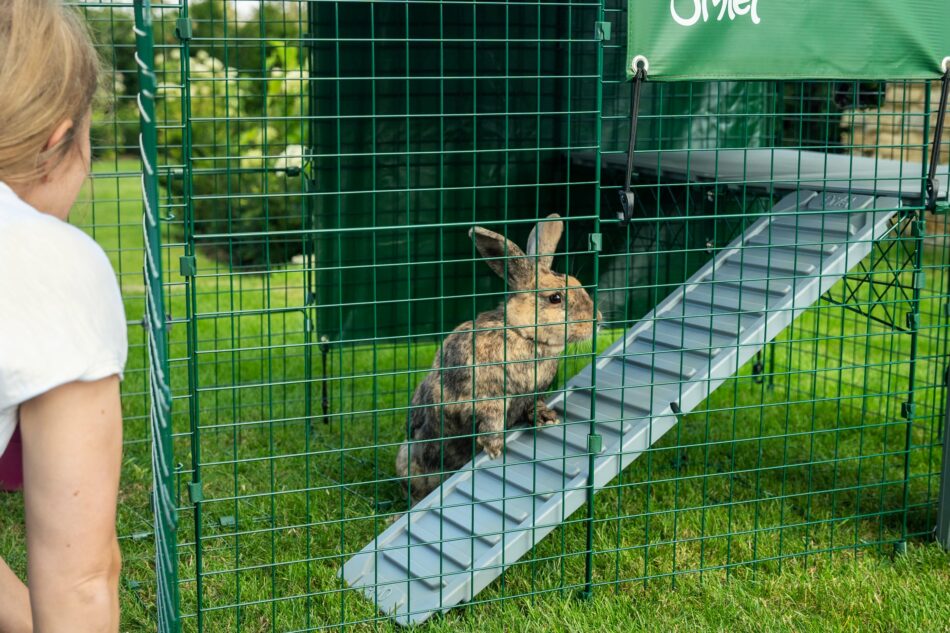
Why rabbits have a hierarchy
In the wild, rabbits live in large warrens with many individuals. To keep the peace in such close quarters, they rely on a clear hierarchy. This order establishes dominant rabbits as the first in line for resources like food and shelter, and helps submissive rabbits understand their place, which reduces the risk of constant conflict. When a healthy hierarchy is in place, the whole group can coexist peacefully.
Domesticated rabbits are no different. Even in your backyard rabbit setup or indoor enclosure, bunnies will establish a pecking order among themselves. Knowing how to tell who the dominant and submissive members are and making sure there’s plenty of rabbit enrichment will help you maintain the peace.
Signs of dominance
A dominant rabbit will usually make its position clear through a mix of bunny body language and behaviors like:
- Mounting — Not always a mating gesture; it’s a way to show dominance over another rabbit. Both males and females will mount other rabbits of either gender until the hierarchy is established.
- Nudging or chasing — Used to move submissive rabbits out of the way. Sometimes chasing manifests as circling, and shouldn’t result in stress or injury.
- Resource guarding — Blocking access to food bowls, hay feeders, or favorite hideouts. This shouldn’t be persistent, just a dominant rabbit staking their claim as first in the desired activity.
- Demanding grooming — Lowering their head expectantly for attention from others. This “bowing” may be met with another bow from the other rabbit until the hierarchy is firmly established.
These are normal parts of establishing hierarchy, but they should settle into routine rather than remain constant.
Signs of submission
The flip side of dominance is submission, and it’s just as important for keeping the peace. A submissive rabbit may:
- Groom the dominant rabbit as a show of respect. The rabbit doing the grooming is acknowledging the elevated position of the other rabbit, and is accepting their place lower in the hierarchy.
- Lay low with ears back to avoid confrontation. This “flattening” is in response to a rabbit feeling threatened by another, and it will usually diffuse tension right away.
- Move away when challenged instead of fighting. Passive behaviors are a sure way to tell which of your rabbits are more submissive.
Recognizing these behaviors reassures you that your rabbits are negotiating boundaries rather than escalating into real conflict.
How the hierarchy is established
When rabbits first meet, or when an established pair goes through changes, the hierarchy must be worked out. During periods of change, or when introducing new rabbits, you can expect to see mild scuffles like quick “boxing” matches or brief chases. You may also see nose-to-nose standoffs until one rabbit backs down. And, most commonly, you’ll notice mounting and chasing until the roles are accepted.
This process can look dramatic, but it’s usually short-lived. The important thing to remember is that dominance isn’t always permanent. It can shift later due to age, health, or personality changes. Keep an eye on your rabbits to make sure all transitions and shifts remain safe.
Healthy vs. problematic behavior
While it’s normal to see chasing, nudging, and mounting during normal bonding and hierarchy restructuring, there’s a line between healthy dominance and problematic aggression. Here are some warning signs to watch out for:
- Persistent bullying of the same rabbit.
- Fur pulling or biting that draws blood.
- One rabbit being isolated or excluded from resources.
In these cases, separating the aggressive rabbit and reintroducing them over a longer period of time may be necessary to prevent further injury and stress.
Top tips for rabbit owners
As their owner, you can make hierarchy establishment smoother and safer. Providing a neutral bonding space like a rabbit playpen gives bunnies a fresh environment to help reduce territorial disputes. Offer more than one feeding and watering station, and provide plenty of rabbit hideouts to prevent competition for resources, and create escape routes with Zippi tunnels and platforms to allow submissive rabbits a way to retreat. And most importantly, remember to be patient. Bunny bonding and hierarchy take time, over the course of several days or even weeks. But once it’s established, your rabbits will have created an environment where everyone belongs and enjoys each other’s company.
Omlet and your rabbits
The right setup makes it easier to manage your rabbits’ social needs. Omlet’s Zippi Rabbit Runs and Zippi Rabbit Tunnels offer plenty of customizable space and entry points, giving rabbits the room they need to retreat or explore during the bonding process. Paired with an Eglu Go Rabbit Hutch, and both dominant and submissive bunnies will be able to call this secure and engaging setup their home.
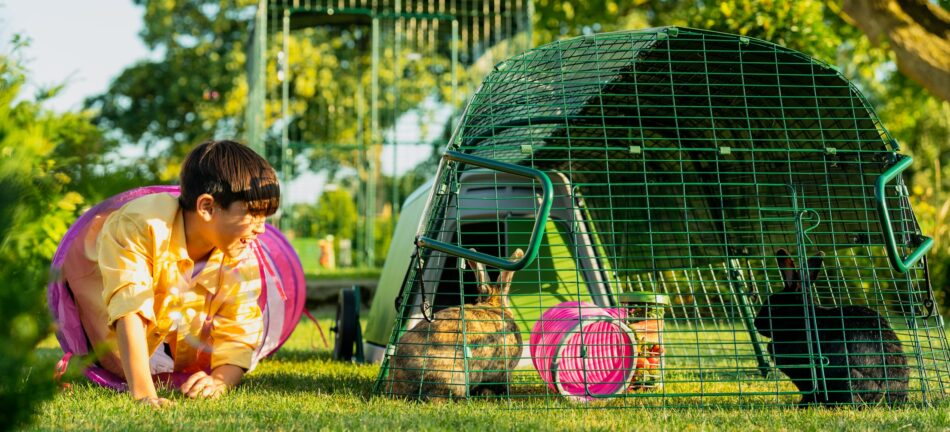

This entry was posted in Pets
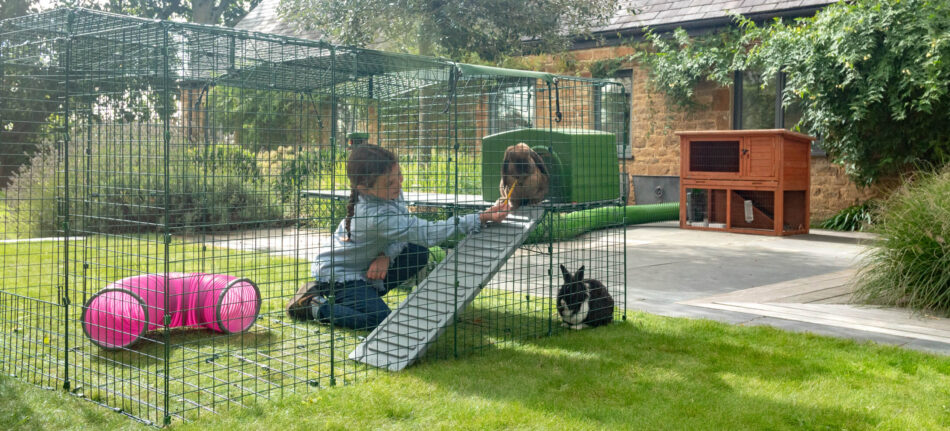
Rabbits that bond with their owners live longer, happier lives. Learning how to build a bond with your bunnies helps you enjoy their company even more, and forges a friendship that’ll span their entire lives. Since rabbits are prey animals, they have an innate nervous nature – and as a result, don’t give their trust as easily as dogs or cats may. But, with some patience, you and your rabbits will be able to understand each other better, deepening the bond between you. Whether you’re a first-time rabbit owner or a seasoned bunny keeper, here are 10 ways to bond with your rabbits.
1. Learn their personalities
Like humans, rabbits have their own distinct personalities and characteristics that set them apart from each other. Some rabbits are very shy when they’re first brought home, while others are outgoing and social from the start. Learning to read your rabbits’ body language is the first step in figuring out their unique personalities. Rabbits make different sounds and change their posture to reflect how they’re feeling. You may also find that you have two rabbits with completely different personalities toward humans – but having an outgoing rabbit can be helpful in gaining the trust of a more timid bunny.
2. Create a shared space
It’s natural for your rabbits to feel nervous or even defensive if you interact with them by reaching into their hutch – after all, this space is their home, and all of their instincts tell them to protect it from potential predators. If you want to spend time bonding with your rabbits, try setting up a play area or run large enough for you to sit inside with your pets. This way, you can start interacting with them on neutral ground. Rabbits feel comfortable when they have something over their heads, so don’t feel bad if the first few times they hide under any covered area you have set up.
While all bunnies should have a comfortable rabbit hutch, your first few interactions shouldn’t be inside of it. Rabbits seek shelter in the form of burrows or dens, which is how they see their hutch. Reaching into the hutch to pick up or pet your new rabbits can startle them, and can eventually create unease inside their safe space.
Instead of infiltrating their hutch, create a shared space in the form of a rabbit playpen. This will enable you to sit inside of an open area to let your rabbits come to you. Don’t be discouraged if your bunnies dart to the nearest cover during your first few attempts to pet them – this is their natural instinct shining through.
3. Offer healthy treats
While sitting in your shared space, offer your rabbits healthy treats by hand. There are plenty of fresh foods that you can feed your rabbits that will go a long way in winning their trust. Leafy greens in particular are both nutritious and easy to offer by hand – their length can be adjusted, gradually luring your rabbits toward you.
Once your rabbits are taking treats by hand, slowly encourage them to hop onto your extended legs or lap. While sitting on the ground, place the treats on your leg or hold them just over your lap. Before long, your bunnies will be bounding into your lap for food and attention.
4. Fill the playpen with toys
Placing more than just yourself inside of the shared space with your bunnies will help them adjust even faster to your presence. Bunnies love burrows, hideaways, and differing heights to gain a new vantage point. Adding Zippi Rabbit Tunnels, Zippi Rabbit Platforms, or Zippi Rabbit Shelters and Play Tunnels are all great accessories to help your bunnies feel more at ease and encourage play. It’s a good sign when your rabbits play while you’re in a shared space – it means they trust you enough to venture out of safety and exhibit their natural behaviors.
5. Give your rabbit new experiences
Rabbits are creatures of habit, but it’s good to change things up from time to time. New foods, toys, or run accessories are fresh and fun ways to break up monotony. And, over time, your rabbits will learn to associate you with these fun additions or changes to their routines. Try rearranging their run, re-routing or adding onto their Zippi Tunnel System, or offering homemade toys like empty paper towel rolls to brighten your bunnies’ day.
6. Petting your rabbit
Once your rabbits are comfortable sharing a space and taking treats from you, it’s time to introduce petting. Physical contact builds a stronger bond between you and your bunnies, but they may not take to it at first. The first time you stroke your rabbits, they may become startled and dart for cover. This too is a natural behavior– one that can be minimized over time. It can take several weeks to be able to pet your rabbits without this reaction.
The best way to introduce petting to your rabbits is to hold your hand low, just to the side of their heads. This way, they’ll be able to see exactly who and what is coming toward them. If you come straight from above their heads and backs, they can’t see what’s coming and will react just like their cousins in the wild running from a bird of prey or other predator. Also, avoid approaching your rabbit directly in front of their heads – they have a “blind spot” due to the location of their eyes, and are unable to see things coming toward their foreheads.
7. Teach your rabbits tricks
After your rabbits have adjusted to being petted, you can start incorporating some intellectual stimulation. Teaching your rabbits tricks will build their confidence, your bond with them, and foster their natural curiosity and behaviors. Start with simple tricks that come naturally to them, like walking through a tunnel or up a ramp with a treat waiting for them at the end. You can slowly build up to more advanced tricks like spinning in a cycle or rolling over. Rabbits can even be taught to play fetch like a dog.
8. Copying your rabbit
This method may seem unusual, but the goal is to behave in ways that your bunnies would expect from others of their own species. This could be you pretending to clean your “paws”, or leaning over to pretend to nibble at some of their food. Make sure you have your rabbits’ rapt attention, otherwise, you’ll be playing bunny charades by yourself. This method is particularly fun for children, especially those who aren’t old enough to have an abundance of patience to wait for their bunnies to come to them.
9. Choose the right time to play with your rabbit
As you observe your rabbits, you’ll see a pattern in their daily routine. There will be times of the day when they’re most active, when they prefer to nap, and when they seek out food or water. Learning their routine will help you determine the best time to play and socialize with them. Choose a time of day when they are most active – this will be the time when rabbits will be most receptive to play and training endeavors.
10. Learning to hold your rabbit safely
The last step in bonding with your rabbits is holding them. It may be tempting to push this step toward the top of the list, but it’s important not to rush them. Being held is the ultimate submission to humans – the truest expression of trust for a rabbit.
Always hold your rabbits in a way that’s most comfortable for them. This may be in a football hold, with your rabbit’s head tucked under your arm, or supported snugly against your body. Some rabbits even prefer being held on their backs – similar to how we hold human babies. Always be sure to support their hindquarters to help them feel secure.
Omlet and your rabbits
Rabbits are gentle animals, and need gentleness in return. Being respectful of your rabbits’ space, personalities, and insecurities will help them see you as a friend instead of a foe. Starting them out in an Eglu Go Rabbit Hutch will begin building the bond between you and your bunnies with confidence and security. And, when you add a Zippi Rabbit Playpen, you’ll be able to cultivate a lasting relationship in a shared space that you can customize and tailor to your rabbits’ needs throughout your lasting relationship.
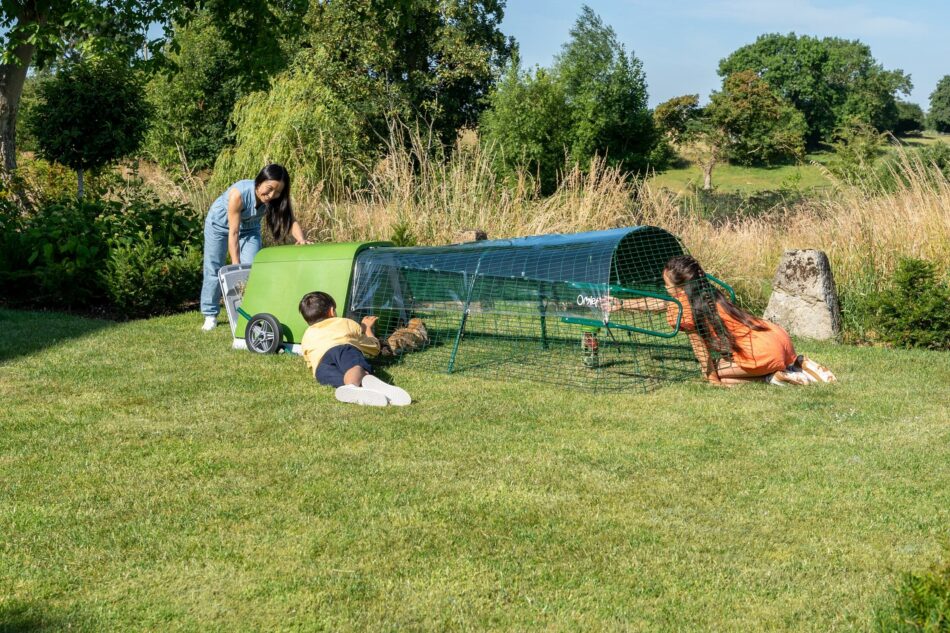
This entry was posted in Pets

This article is a part of our Pride of Omlet series, a collection of amazing stories which shine the spotlight on extraordinary pets and share their selflessness, bravery, talent and compassion with the world.
-Written by Anneliese Paul
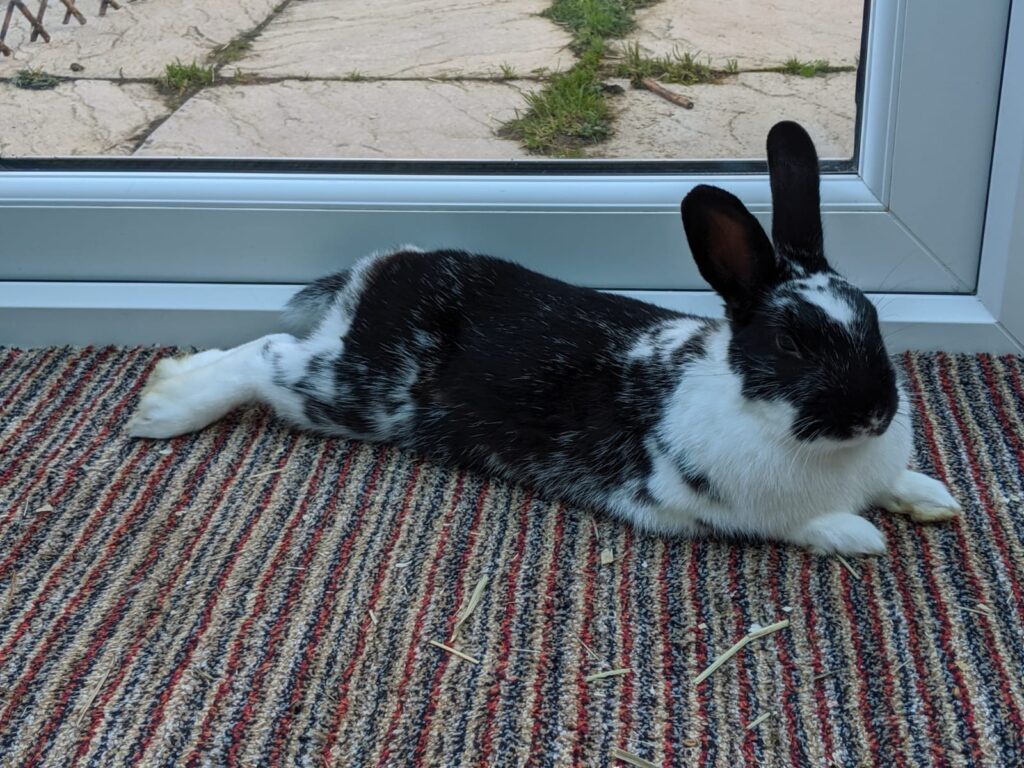
It’s hard to describe how frightened Pixie the rabbit was when the RSPCA relocated her with an experienced rabbit owner. Eighteen months on, cheeky little Pixie lives in the lap of luxury and is learning to be loved by her adoring human, Wendy.
Wendy had two beautiful rabbits, which she adored. A jet black male Rex rabbit called Jensen and his chocolate brown partner, Havana. But in 2019, Havana died suddenly of pneumonia, and Jensen grieved so severely that he wouldn’t leave his bed. He was the most miserable, unhappy rabbit.
Wendy wanted him to bond with another rabbit, so she went to the RSPCA Canterbury and found Pixie, who had been severely neglected. Pixie was rescued with her partner, but sadly, this rabbit didn’t survive. Pixie was close to starvation, she was skin and bones and had to be fattened up before she was ready to be relocated to a new home. Wendy wanted to give her the loving home she deserved.
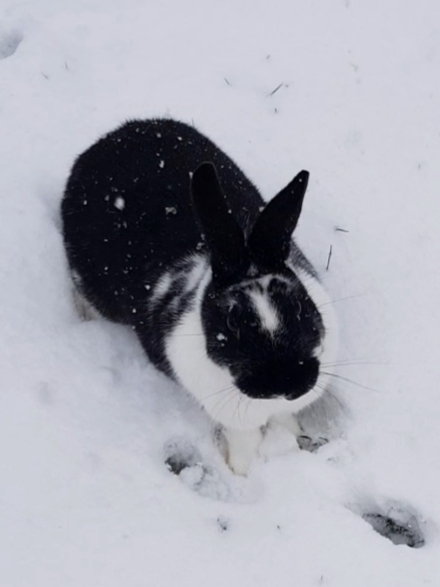 Thinking she would be a perfect match for Jensen, Wendy took Pixie home. She had divided the rabbit house so that she could slowly introduce them. After about a month, they were lying next to each other, separated only by the wire, so Wendy decided it was time. However, Pixie was traumatized and her fear presented in aggressive behavior. She couldn’t handle it and bit Jensen. She was agitated and frightened of everything. For a while, even putting food down for her was tricky. She would lunge at the hands that fed her. It was a terribly sad time for Wendy to see Pixie so distressed.
Thinking she would be a perfect match for Jensen, Wendy took Pixie home. She had divided the rabbit house so that she could slowly introduce them. After about a month, they were lying next to each other, separated only by the wire, so Wendy decided it was time. However, Pixie was traumatized and her fear presented in aggressive behavior. She couldn’t handle it and bit Jensen. She was agitated and frightened of everything. For a while, even putting food down for her was tricky. She would lunge at the hands that fed her. It was a terribly sad time for Wendy to see Pixie so distressed.
Wendy kept Pixie on her own, and slowly slowly, Pixie began to trust her. Now, 18 months on, she puts her nose up to be stroked, and she’ll hop alongside Jensen. Their Omlet runs, run parallel, so she’s got her space, and he’s got his. They also have a shed divided in two with three levels, windows, balconies, and a flap to their outside Omlet runs, which are connected with tunnels to the conservatory. The gate system on the Omlet runs means Wendy can let them both have time in the house. What was once Wendy’s dining room is now a rabbit playroom with a box, some steps and tunnels so they can just mess around and do bunny stuff. They take turns to come in, and Wendy leaves the door open, so they don’t get too warm.
Before she starts work in the morning, she makes the rabbits a little salad. Kale, Cavalo Nero or Spring Greens are the staples, mixed with herbs like parsley, mint and basil. And in the Summer, she’ll pick fresh leaves and rose petals. They have 3 or 4 different kinds of hay to choose from in their runs, and for a treat, Wendy likes to give them bunny biscuits, or strawberries which they absolutely love.
From her sad beginnings, Pixie has blossomed with a loving owner who understands her past, builds up her confidence and feeds her a delicious diet. Jensen has a new partner, Tinker-bell, a blue-eyed white mini Rex. Wendy simply adores all three of her beautiful rabbits, but especially Pixie. She’s a survivor.
“Almost every day, she could reduce me to tears. She’s so loving and responsive. I’m just absolutely amazed that this little rabbit found it in her heart to actually forgive humans.”
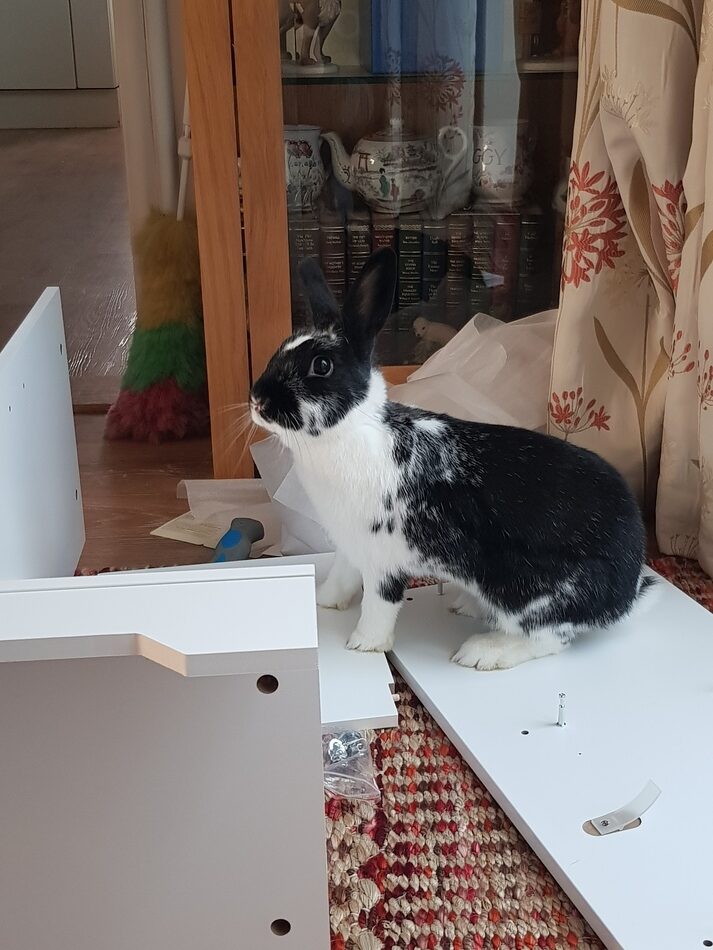
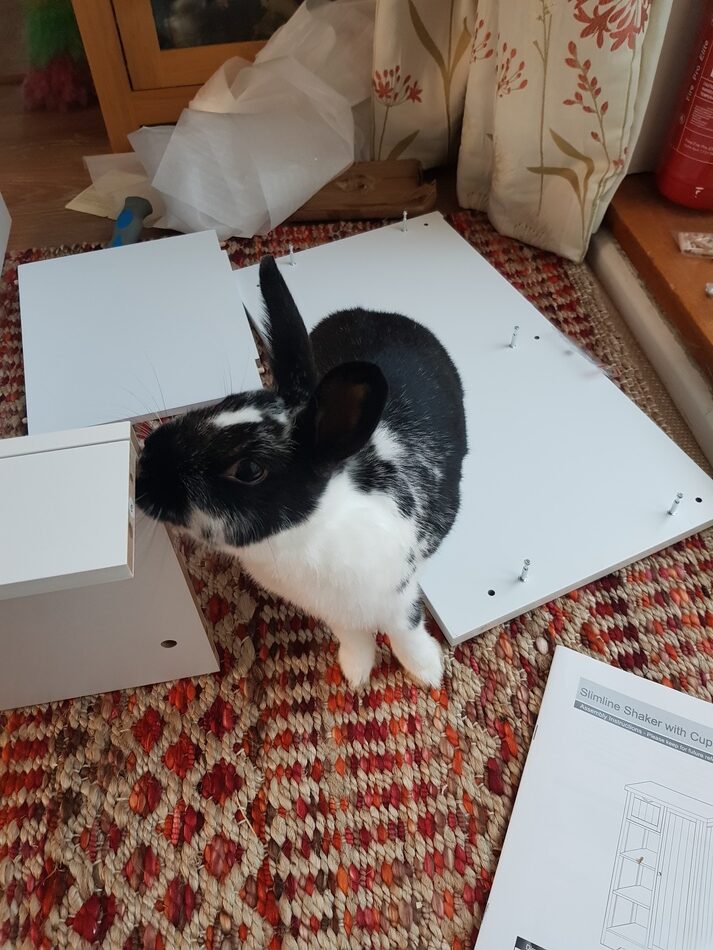
This entry was posted in Pets

Some animals, such as rabbits and guinea pigs, are herbivores. Others, like hamsters, are omnivorous. Finally, there are also carnivores like cats that cannot survive without meat.
All animals need to have their nutritional needs satisfied. However, this does not mean you can’t have a vegan dog. Vegan cats, though, are a lot trickier.
Can my dog have a vegan diet?
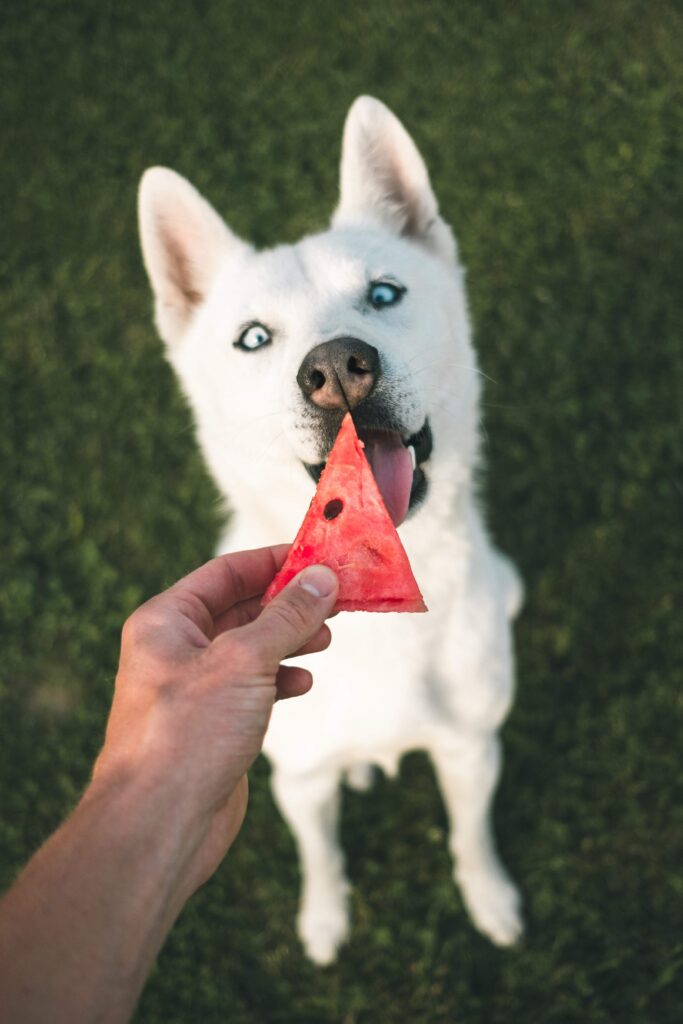 If you were to meet a species of animal for the first time and had to make an accurate guess about its diet, you would get lots of clues by looking at its teeth. The teeth of a dog, like the teeth of a bear, proclaim loud and clear that this animal is an omnivore – that is, one that eats both meat and vegetables. If you think of your dog as a domesticated wolf, you get a good idea of its natural diet.
If you were to meet a species of animal for the first time and had to make an accurate guess about its diet, you would get lots of clues by looking at its teeth. The teeth of a dog, like the teeth of a bear, proclaim loud and clear that this animal is an omnivore – that is, one that eats both meat and vegetables. If you think of your dog as a domesticated wolf, you get a good idea of its natural diet.
However, as the panda proves, a supposed meat-eater can sometimes get by perfectly well on a vegan diet. A panda’s teeth are similar to any other bear’s – long canines for meat-eating and molars for grinding vegetation. And yet pandas don’t eat anything other than bamboo. So, if a bear can be vegan, does that mean you can have a vegan dog?
The answer is yes – but it’s a yes with lots of small print! A dog requires a diet that contains the fats and proteins it would get from meat. It is dangerous to ignore this basic need and simply feed your pet with whatever you please. Some dogs have delicate stomachs. Also, a low-fat/high-fibre diet can cause potentially life-threatening problems. A diet that excludes meat should never be fed to a dog without the advice of a professional pet dietician.
The collagen, elastin and keratin found in meat diets are not easily replaced by veggie equivalents. Your dog will also need the ‘long chain’ omega-3 fats found in animal products such as egg, fish and some meats. Vegan omega-3 fats are not the same as animal-derived ones.
All of which presents a headache for the vegan dog owner. There are, however, products available that claim to let your dog live a healthy, meat-free life. Before you take the plunge, it is essential to seek professional, scientific advice and guidance. Compromise is usually the best choice here – a vegan diet supplemented by some of the animal-derived essentials. Crickets, for example, can provide lots of the amino acids and keratin a vegan diet lacks, and they’re 65% protein.
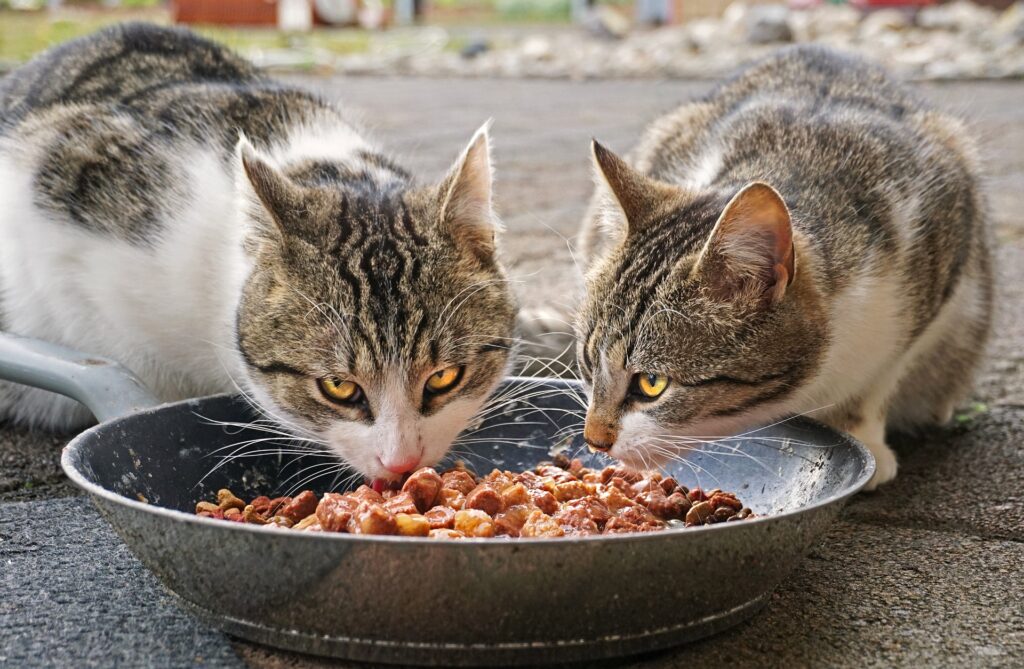
Can my cat have a vegan diet?
The compromise approach is even more important for cats. These are amongst the planet’s true carnivores, obtaining all their dietary requirements from other animals.
The main challenge with minimizing the meat in a cat’s diet is that, unlike many mammals (including dogs), cats cannot produce certain proteins. They have to absorb these from the meat and fish in their diet. Amino acids are another issue – cats deficient in the animal-derived amino acid taurine, for example, usually succumb to a specific type of heart problem.
Even a fortified vegan cat food cannot be confidently recommended. Turn the situation on its head, and try to imagine weaning a rabbit onto a meat-only diet, and you will get some idea of the challenge – and the ethics – involved.
There are some lab-grown ‘meat’ products in development, with vegan and vegetarian cat owners in mind. However, whether these will arrive – and remain – on the market any time soon is hard to guess.
For many vegan pet owners, there is a huge ethical issue involved in feeding the animals they share a space with. Ethics, however, include the animal’s needs too, and it’s an almost impossible issue to resolve when it comes to cats. If you are able to reduce but not eliminate the meat in your cat’s diet, that’s the safer option.
Top 10 pets for vegan households
There are, of course, plenty of other pets that don’t eat meat, or that eat some meat but can still thrive on a meat-free diet. Here are our ten favorites.
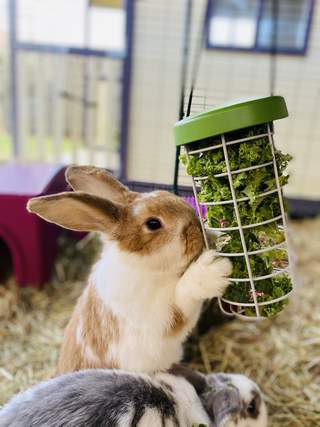 1. Rabbits. No problems here – rabbits are happy vegans, with diets based on hay and vegetables. You could argue that the soft pellets they eject and then eat are animal products of a sort, but they are simply semi-digested vegetation.
1. Rabbits. No problems here – rabbits are happy vegans, with diets based on hay and vegetables. You could argue that the soft pellets they eject and then eat are animal products of a sort, but they are simply semi-digested vegetation.
2. Guinea pigs. Like rabbits, these wonderful little characters thrive on a 100% vegan diet.
3. Hamsters. Most hamster owners give them store food, you don’t always know what’s in it. However, hamsters, like rats and mice, can do without meat.
4. Gerbils. Like hamsters, gerbils are omnivorous. They have sensitive stomachs and need a quality pellet mixture. Too much fresh produce can harm their digestive system.
5. Mice. Although they will eat pretty much anything in the wild, mice can thrive on vegan diets; but it is still best to use a food mix prepared specifically for them. This ensures that they will not be deficient in any of the vitamins and minerals they need.
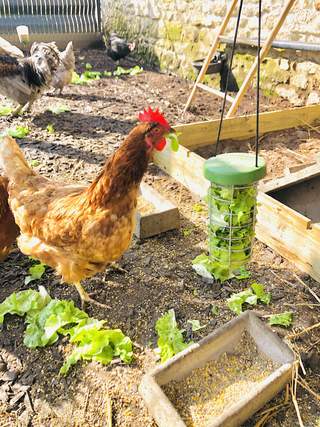
6. Rats. These are the most omnivorous of rodents, but as long as you feed them a vegan mix that has been fortified with all the nutrients they need, they will thrive. Be careful, rats who eat too much animal fat tend to become fat and die prematurely.
7. Chickens. If you watch a free-range hen, it soon becomes clear that she will eat anything – grass, beetles, worms, and everything in your vegetable patch if you’re not careful! Most chicken feed emulates this mix of plant and animal products. However, it is possible to buy vegan chicken feed, and circumstantial evidence suggests that hens can thrive on it. However, they are likely to produce fewer eggs, and you will not be able to stop them scratching for worms and bugs, no matter how vegan the layers pellets are!
8. Parakeets and parrots. Vegans will have no obstacles to face with budgies and parrots, unless the birds are being bred. Egg-brooding female birds need a protein boost, normally delivered via an egg-based food or cooked meat. Vegan alternatives are available, though.
9. Finches. Many finch species enjoy bugs and mealworms as treats, but these are not an essential part of an adult finch’s diet. These birds thrive on a mixture of seeds and fresh vegetables.
10. One for reptile fans. When you think of pet snakes and lizards, you probably have an image of dead mice or doomed crickets. However, there are a few commonly kept pet reptiles that eat a 100% vegan diet, the most popular being the Green iguana. Getting the balance of vegetables just right is very important for the animal’s health, but meat is certainly something you won’t have to worry about.
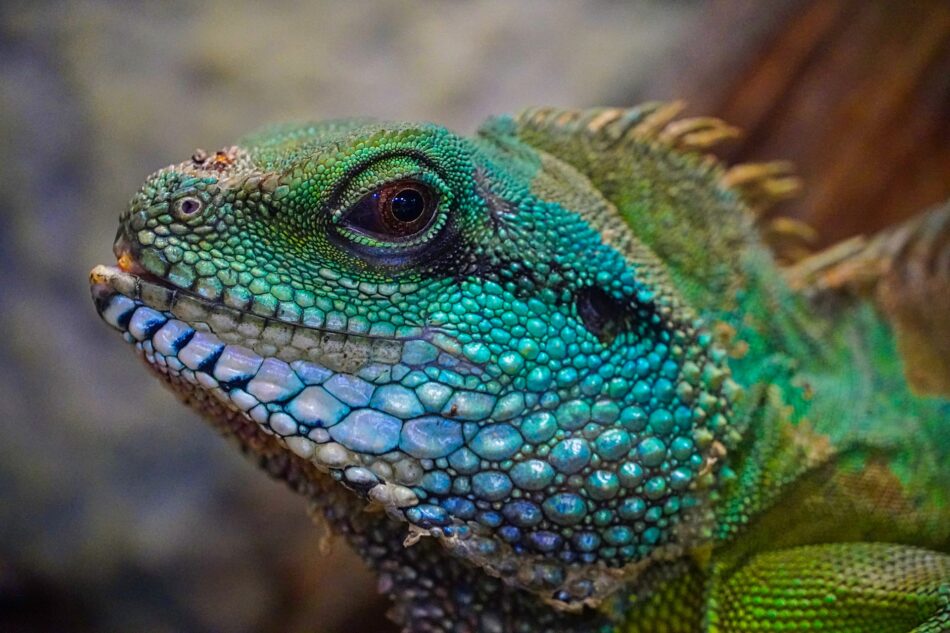
There is no shortage of choice when it comes to vegan pets. Keeping a vegan cat or dog is a much trickier proposition, though. And with all these animals, a balanced diet that matches the pet’s nutritional requirements should be your primary goal.
This entry was posted in Birds
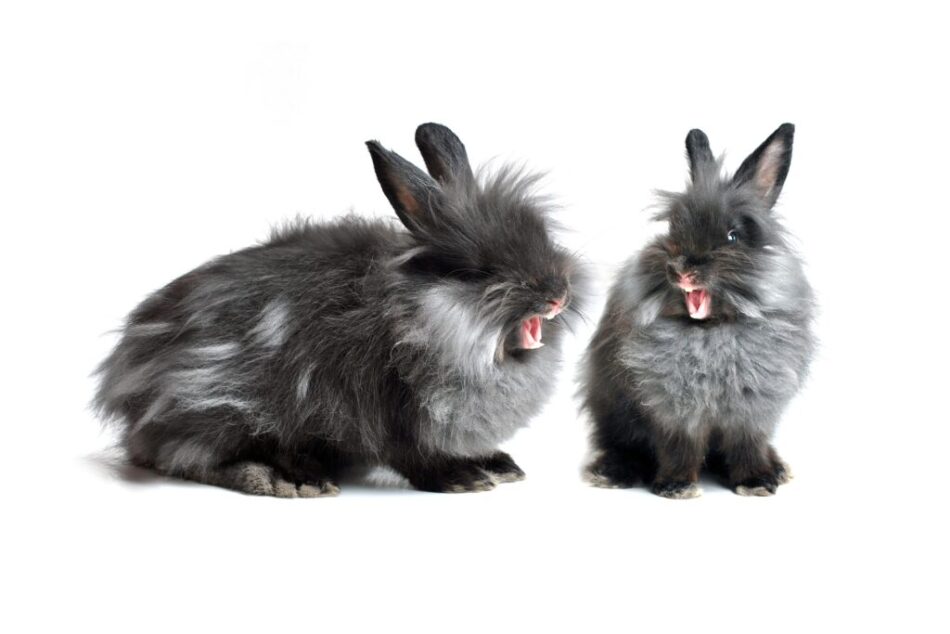
Rabbits are usually peaceful creatures who love to play and socialise with their owners. But what do you do if your rabbit starts showing signs of aggression? It’s tough to see your pet stressed, and it’s natural to want to help them. Here, we outline a few ways you can minimise bad bunny behaviour and start enjoying the time you spend with them again!
What is aggressive behaviour in rabbits?
There are two major kinds of aggression in rabbits, the most typical being defensive behaviour surrounding their habitat. If your rabbit bites when you reach your hand into their cage or hutch, it’s likely to be territorial defensive aggression. Another kind of aggressive behaviour occurs between your rabbits – for example if they are fighting each other to the point of injury.
It can be upsetting to see your bunny get hurt, and hard to know what to do. A small amount of fighting is natural between your pets, but if you can see blood on their fur or in the hutch then it’s possible that the anger is getting out of hand and the bites are getting nasty.
How to help with territorial aggression and biting
If your rabbits bite your hand – or try to – consider how and where you approach your pet. The hutch is often a bolt hole and ‘safe space’ for a bunny and is where they spend most of their lives. If you reach in unexpectedly, it is natural that they might be scared and defensive. Rabbits are prey animals in the wild and are especially jumpy when ‘cornered’ in their safe space!
You may find that if you start to interact with your rabbit in a non-hutch setting – such as a run or play area – you have more chance of a peaceful and happy interaction. Try sitting with your rabbit in the run for a few hours every day, and then begin to slowly approach with your fluffy friend’s favorite rabbit treats. After spending time like this, you may find that your rabbit starts coming to you more and more, and if the rabbit is initiating the approach, aggression is much less likely.
By spending time with your rabbit in this non-hutch environment, you are teaching your pet that you are not a predator, and that you can be trusted to approach them. Once the trust is established, you should be able to approach the rabbit in its rabbit hutch with no problems.
How to stop aggressive behaviour between your rabbits
If you have noticed fighting between your rabbits, and if this seems to be more than just their normal play fighting, you may need to think about how much space they have in their hutch. It could be that your rabbits have grown since you bought them, and their once spacious house is now a little too small for two. It could be that they have spent little time in the run over winter, and so they’ve become a little ‘house-bound’ in their hutch. Cabin fever affects humans and pets alike!
Whatever the reason for the bunnies’ bad moods, it is important that your rabbits should feel happy and relaxed in their hutch. The fighting will likely ease off if they have more elbow room. Rabbits are territorial animals, and they each need their own space as well as a shared space.
Try distracting your brawling bunnies by clapping your hands. The noise will distract them and will hopefully teach your rabbit not to fight. A particularly aggressive rabbit can be deterred by spraying water on their nose – but this isn’t something you want to be doing too often, so if, after the first few sprays, it isn’t making any difference, it’s time for Plan B.
If you decide to invest in a larger hutch but your rabbits continue to show aggressive behaviour, you may have to separate them into two different hutches. That’s Plan B!
The benefits of spaying rabbits
Spaying (also known as neutering) is the term for stopping your pet from having babies and is accomplished via surgery. If your rabbits were from a pet shop, it is likely that they have already been spayed – but if you got your rabbits from a friend, it’s always a good idea to take them to the vet and ask about spaying.
If your rabbit has not been spayed, they are much more likely to exhibit aggressive behaviour to you and any fellow bunny who shares their hutch.
It is common for owners to keep male rabbits or female rabbits in single-gender pairs, and this can lock them into a mating-related feud that neither can win. Your rabbits could be fighting over who is the most dominant in their shared territory, but this fighting is much less likely to occur if they have been spayed.
Equally, if you have decided to keep a male and female rabbit together, it is a good idea to get them spayed, as rabbits can have up to fifty baby bunnies a year! Fifty bunnies may sound cute but consider how difficult it could be to care for and house that many animals!
There are other benefits to spaying your rabbit other than reducing their aggression, such as reducing their chances of getting mammalian, ovarian or testicular cancer. Spayed rabbits are also much easier to train, and are more sociable generally.
If you have only recently brought your pet rabbit home, they may need a little time to get used to their new space and become comfortable. It is natural for any new pet to be nervous and skittish at first, and this could lead to a few aggressive behaviours, including biting, early on.
It’s important to know that your rabbit is more scared of you than you are of it, and that just because it has bitten you doesn’t mean that you won’t end up being the best of friends! If you feel nervous about establishing contact with the rabbit, talk to a friend who has had rabbits for a little longer, or check out some of the reassuring ‘how to’ guides available online.
Just remember that having a rabbit is hugely rewarding and it’s worth spending time hand-training your pet from the outset. As long as they have enough space and no aggressive ‘mating rivals’, they should be every bit as calm and cuddly as you could hope for.
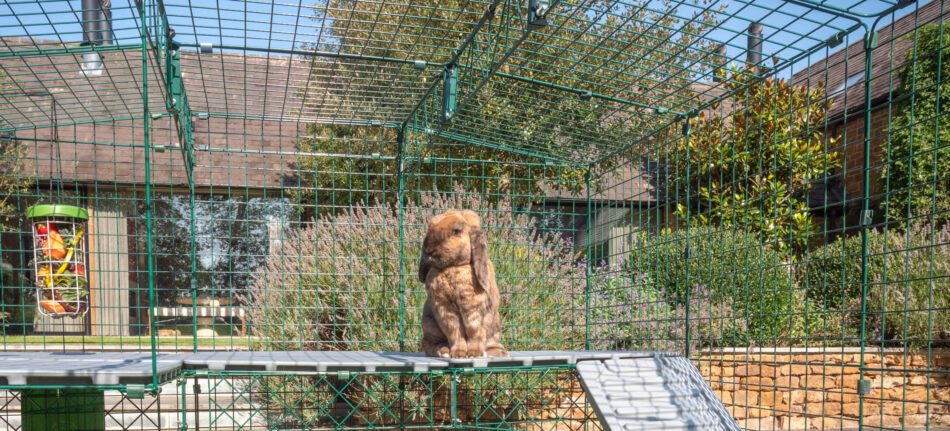
This entry was posted in Rabbits
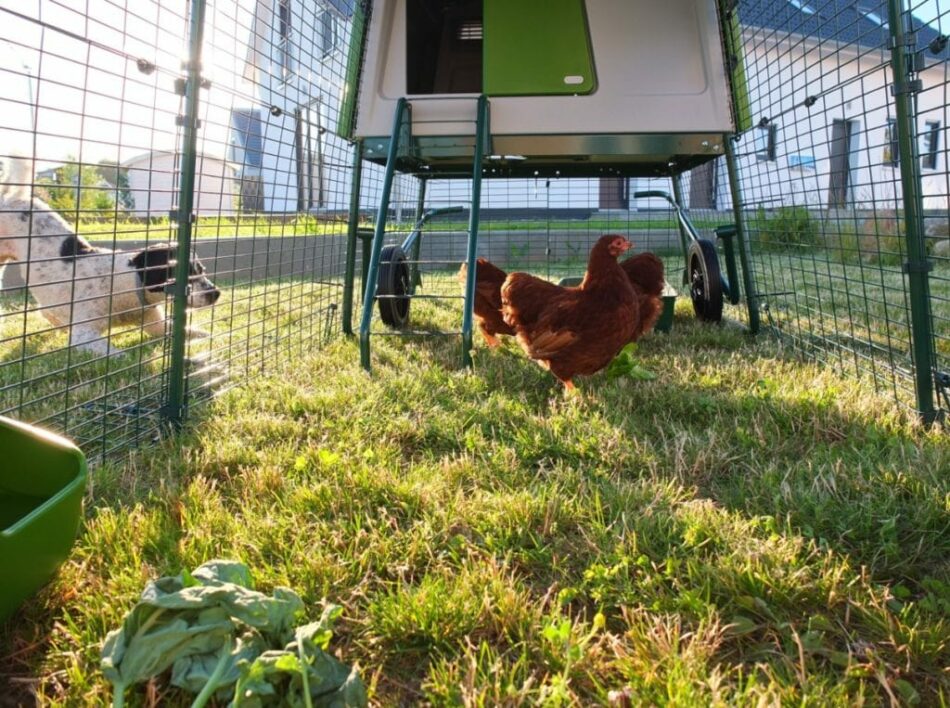
You can keep chickens with other pets when the proper preparations and precautions are in place. Some pets like cats and dogs may have an innate prey drive that chickens can trigger, so it’s important to take introductions slowly to ensure success. With these tips, you’ll be able to confidently introduce your current pets to your chickens, or introduce new pets to your existing flock with confidence.
Keeping chickens with dogs
Dogs are the most common pets in the world, with millions kept as pets across the country. So, if you’re among the many dog owners, adding chickens to your family is possible once you consider your dog’s temperament and trainability.
Assessing your dog
If you’re a dog owner, the first thing to consider is their temperament. Different dog breeds may also react differently to birds as part of their nature. For example, breeds like Labrador Retrievers or German Shorthair Pointers may become easily excited around birds due to their natural hunting and retrieving drives. Other breeds that may have increased prey drives include:
Regardless of their breed, if your dog becomes excited or overly curious around small animals, their behavior will likely carry over to chickens. If your dog loses their mind over the birds at your backyard feeder, or drags you to investigate the park ducks on your evening walks, they’ll likely stress out your flock – and themselves.
Dogs without a prey drive or with little interest in birds will likely not pose a problem to your chickens, but all dogs react differently when new pets enter their territory. Usually, most dogs will adjust to the new backyard occupants just fine after an acclimation period. You will likely see your dog expressing interest in your chickens at first – hanging around and sniffing the coop. They may even express a desire to interact with your chickens through playful postures and behaviors. Understanding your dog’s body language around your chickens will help you determine what their relationship will be like.
Chickens are prey animals, and can be hurt easily. Dogs cannot play with chickens as they would with other dogs or even other pets. It’s important to teach your pup that chickens are fragile friends – not toys or something to hunt.
Teaching dogs to get along with chickens
Unless leashed walks make your dog overly excited, their first encounter with your chickens should be done with a dog collar and lead. Make sure their collar is tight enough that they don’t slip out, but not so tight that it’s uncomfortable. Walk your dog up to your chickens’ enclosure and let them sniff. Maintain a tight leash until you see your dog’s reaction, and allow the lead more slack slowly to reinforce good behavior.
Let your dog watch you spend time with your chickens. This should be done with your chickens in the safety of a strong walk in chicken run. If your dog does more than sniff or hang around the run, take a step back and approach their interaction from a different angle.
It could take several weeks for your dog to fully accept your chickens. Some other ways to help your dogs adjust to your chickens include:
- Setting up chicken fencing around the outside of your flock’s run for your dog to observe them at a distance.
- If your dog has a run or playpen, place it next to your chickens’ run and slowly decrease the distance over several days until they are side-by-side.
- Reward your dog with their favorite treats each time they are calm around your chickens.
Make sure to never leave your dog unattended with your chickens – especially in the beginning. Even if they can’t get into the run with them, an excited dog’s barking can easily stress your flock out.
Keeping chickens with cats
Cats are more difficult to train than their canine counterparts, and are decidedly less predictable in their behavior. But the good news is that most cats don’t see a large hen as potential prey the same way a dog might. Most cat owners will agree that their cats show little to no interest in their chickens. In fact, cats and chickens have a somewhat symbiotic relationship.
Birds and their feed attract rodents, which a cat would much prefer over your hens. So, when your cat is able to patrol your chickens’ surroundings, chances are good that any potential rodent problem will be nipped in the bud.
Some cats may show increased interest in your hens. This largely depends on your cat’s breed and temperament. Cats will pose a greater threat to chicks rather than grown hens, but by keeping your flock in a strong chicken coop and run, you’ll ensure they stay safe from your cat.
Keeping chickens with guinea pigs
It may be tempting to keep some cute cavies in with your chickens, but in reality it’s not wise. Chickens will likely pick on them, and with their short legs, guinea pigs can’t get away from them quickly. Their dietary requirements are also very different, and your chickens may eat your guinea pigs’ food in favor of their own, which means neither animal will be getting the nutrients they need. If you have cavies and want to house them near your chickens, it’s best for them to have their own guinea pig hutch and run.
Keeping chickens with rabbits
Rabbits on the other hand are fast enough to fend for themselves against chickens, and if raised together from a young age, can do well around chickens. Still, they require their own dietary needs and clean sleeping quarters. They don’t roost like chickens, so they’ll need their own burrowing space in the run or under the coop.
The easiest way to achieve this is by adding walk in chicken run partitions. This will allow you to create “rooms” for each species to ensure they all get what they need. You can open the partition doors to allow everyone to be together whenever you’d like, or create a third space as a common area.
Remember to try to give each species as much space as possible in their respective areas to make them feel safe and comfortable.
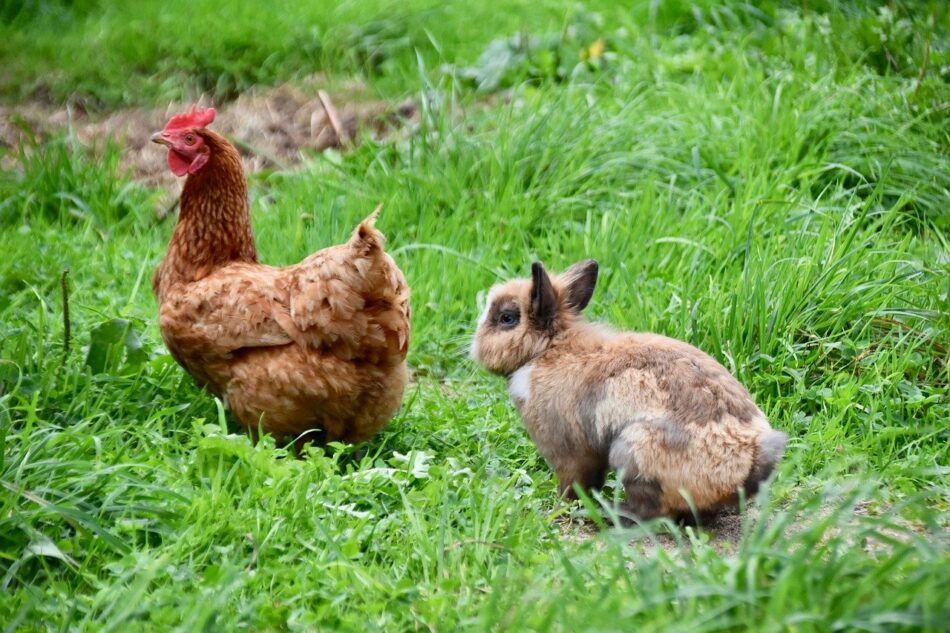
Chickens and other pets
Chickens can also mix happily with goats, and with female ducks (males will tends to bully them). Ironically, they do not mix with birds in an aviary. They will eat anything that falls to the aviary floor, but they will also happily peck the other birds whenever they can and may attract rats and mice, which will cause problems for the smaller birds.
If you live in a rural setting, you can keep chickens with other barnyard animals. Chickens mix happily with:
- Goats
- Sheep
- Cows
- Alpacas or llamas
- Pigs
- Female ducks, guinea fowl, peacocks, geese, or pheasants
Any other avian species kept with chickens should be docile and preferably female, as males can bully hens. Smaller birds like quail or pigeons will likely get pecked at by chickens, so it’s best to stick with larger birds as run-mates. Small pets like hamsters, gerbils, turtles, or frogs should never be kept with chickens – they will be pecked at and killed.
Omlet and your pets
Omlet has all of the pet products you need to keep your furry and feathered family members healthy and happy. Having multiple types of pets is exciting, and through our line of chicken coops, chicken runs, and walk in run partitions, you’ll be able to create a safe haven for all of your animals to enjoy. And, by knowing that Omlet products are protecting your flock, you can rest easy knowing that you’ve provided them with the best chicken housing solutions available.
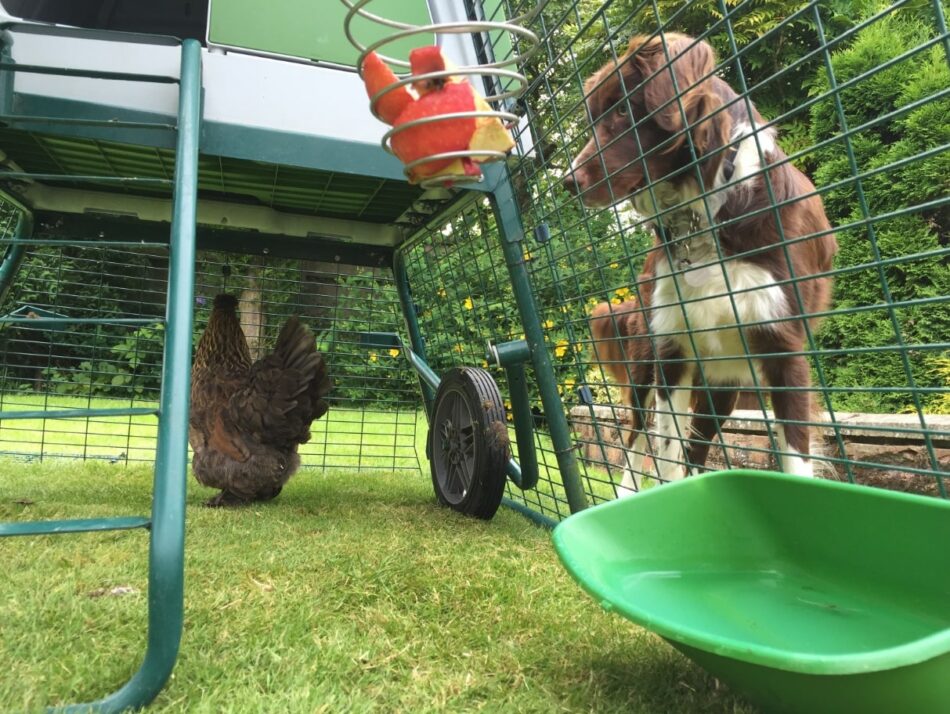

This entry was posted in Budgies
Wondering how to teach your guinea pigs and rabbits new tricks? One of the most rewarding experiences you can have with your pets is through teaching them tricks— and it’s a lot easier than you might think. Rabbits and guinea pigs are social animals that benefit from spending time with their owners through learning and playing. Discover how teaching your pets new tricks is a fun way to build their trust and confidence.
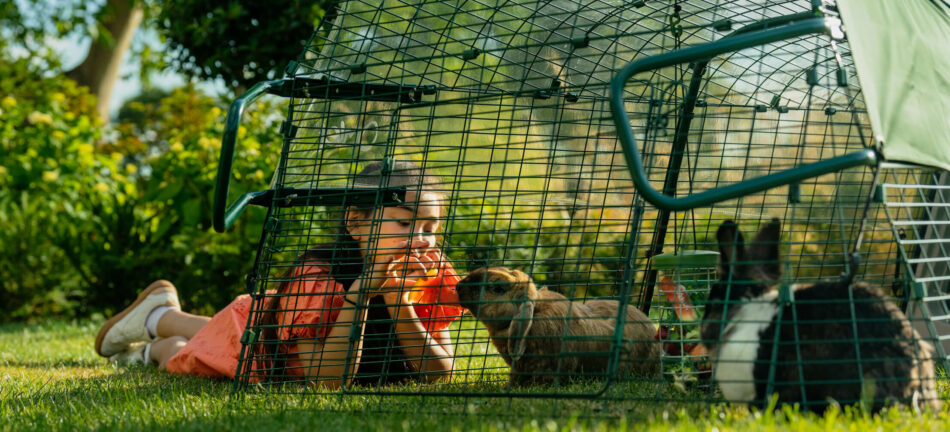
How to start training your guinea pigs and rabbits
Training rabbits or guinea pigs is most effective when you can repeat it every day – even if it’s only for five or ten minutes. Not only will your pets appreciate the extra attention, but having a repeated routine will help them remember the tricks you’ve taught them.
To teach your guinea pigs and rabbits tricks, the first thing you’ll need is a quiet space free from distractions. Zippi Rabbit Runs and Playpens are ideal, giving you a secure and familiar space where you and your pets can focus. You will also need some of your rabbits’ and guinea pigs’ favorite treats to encourage them and reinforce their learning.
It can be helpful to separate your pets when training them, but some pets can benefit from learning from each other. For example, if you have an older trained rabbit and a young, untrained one, the young rabbit can learn tricks easier by copying their more experienced friend. And don’t worry about old dogs and new tricks – your pets are never too old to pick up new things.
Rabbit and guinea pig tricks for beginners
When you start to train your guinea pig or rabbit, it’s all about patience and perseverance. Your pet might not seem interested in learning initially, but as you continue to reinforce their learning with treats, you will find them routinely coming back for more. Start with something simple, such as “circling” — a perfect trick for both rabbits and guinea pigs.
Training your rabbit or guinea pig to circle
To teach your pet how to perform a circle, grip a treat tightly between your fingers and hold it close to your pet’s mouth. Then lead your pet around in a circle with the treat, so that it spins in a tight circle. Repeat this until your pet spins around without you leading them, occasionally reinforcing them with the treat. It’s important that you only give them a reinforcement treat when they successfully do the trick. Eventually, the flick of your wrist will be all the encouragement that your pet needs to perform this trick — provided that there’s a treat in store for them after their performance.
Don’t worry if this takes some time to learn – the first trick can be the hardest for your rabbit or guinea pig, but once they have mastered a circle, you’ll both have the confidence to learn even more tricks. If your pet is struggling learning how to circle on command, try encouraging them to turn in the other direction. Like us, our pets are either left or right-footed, so the direction you ask of them needs to be in line with their natural inclination.
How to make rabbits or guinea pigs come when called
Another great first trick is teaching your rabbits or guinea pigs to come when they’re called. Not only is it endearing and impressive, but it’s also practical for your pet to approach you on command.
As with many tricks, the key to teaching your rabbit or guinea pig to come when called is food. Offer a treat when you are close to your pet while saying their name. Eventually, they will come to associate their name with the treat. The next step is to call your pet from farther away, showing them the treat. Repeat their name as they take their reward. After two weeks of this regular exercise of calling and treating, try calling your rabbit or guinea pig’s name without showing them a treat.
Moving on to more advanced tricks
Once you and your guinea pigs or rabbits have mastered a first trick, it’s time to move on to more advanced feats. The more tricks your pet learns, the more confident they will become — and the closer your bond will be.
How to teach rabbits and guinea pigs a figure eight
Challenge yourself and your pets by encouraging them to walk in a figure eight between your legs. As with teaching them to circle, hold a treat in front of your rabbit or guinea pig while encouraging them to follow a figure eight pattern through your legs. Reward them with the treat as soon as the pattern is complete. Some pets may need a treat halfway through their pattern to maintain their focus — but eventually they’ll learn to complete the figure eight before expecting their reward.
How to make rabbits and guinea pigs jump through hoops
To teach your rabbit or guinea pig to jump through a hoop, you’ll need a stick and some treats. Begin this method of stick-training, hold the tip of the stick near your rabbit or guinea pig. When they turn to investigate it, offer them a treat. This will reinforce the idea that the stick is associated with treats.
Once they’re familiar with this routine, hold a hoop close to your rabbit or guinea pig, slightly off the ground. Hold the stick on the opposite side of the hoop, and wait for your pet to hop through to the stick. Offer a treat as soon as they’ve completed the hop. Once your rabbit or guinea pig is hopping through the hoop toward the stick, you can offer the hoop without the stick. Reward them with a treat as soon as they hop through.
You can slowly increase the height of the hoop for rabbits, but keep in mind that guinea pigs will only be able to perform a slight hop. Rabbits can reach impressive heights thanks to their acrobatic prowess, so be sure to offer a challenge to them.
Remember: treats are in moderation
Don’t forget that the treats given to your pets are a part of their diet — and if you’re sticking to your daily training, you may need to incorporate healthier snacks as training-treats to make sure their diet remains balanced. Leafy greens, green beans, carrot tops, or herbs are all great treats that are both healthy and satisfying for your guinea pigs and rabbits.
Omlet and your guinea pigs and rabbits
Help your rabbits and guinea pigs reach their full potential and amaze yourself in the process. With Zippi Tunnels and Zippi Run Platforms, you’ll be able to teach your pets new tricks with ease, and give them the elements they crave in their environment between training sessions. And, with our outdoor rabbit and guinea pig runs, you’ll have the space you need to achieve all of your trick-teaching goals.
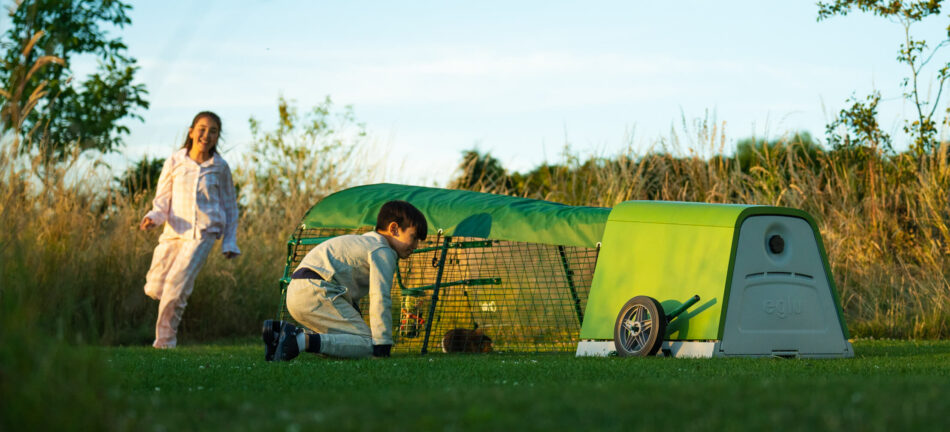

This entry was posted in Guinea Pigs
Older rabbits need a little extra care. But when exactly is a bunny ‘old’? It very much depends on the breed. Larger rabbits have shorter lifespans than smaller ones, which means they become senior rabbits sooner than medium and small breeds.
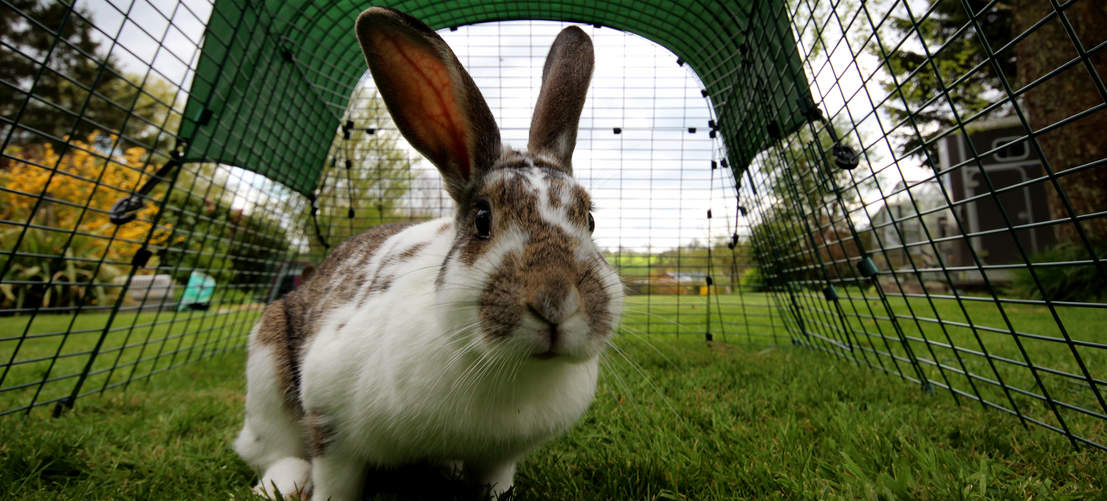
At what age is a rabbit considered old?
As a general rule of thumb, small rabbit breeds, which live around 12 years, are seniors when they reach 8. Medium-sized rabbit breeds live up to 10 years and can be considered senior at 6 years. The large rabbit breeds have much shorter lifespans – just 4 to 7 years – and reach old age at 4.
The shortest-lived rabbit breeds are like small pets such as gerbils, hamsters and rats, in that they only have a few months of senior status at the end of their lives.
How do you take care of an old rabbit?
Here’s how to make sure those senior rabbit years are as healthy and happy as possible.
Make sure you give them the right food
Rabbit care is largely about food, and a healthy diet is essential throughout a rabbit’s life. As your bunny gets older, you should consider buying specially formulated pellets or nuggets. There are several different brands, and they contain the optimal balance of vitamins and minerals for aging rabbits. Older rabbits can’t gain too much weight – or, indeed, lose weight – during this dietary transition, so you should weigh them regularly to maintain the correct weight. In addition to the special pellets, senior rabbits should be fed lots of hay and fresh foods as usual.
Don’t add supplements to your rabbit’s diet
Rabbits get everything they need from a diet of hay, fresh food and appropriate pellets. Extra calcium, for example, can cause digestive problems or stones in the urinary tract.
Make sure your bunny gets plenty of exercise
Getting old doesn’t mean sitting around all day – rabbits of all ages need to move around to stay happy and healthy. A run will naturally allow your bunnies to hop, skip and jump around. A tunnel layout such as Omlet’s Zippi system is nothing short of essential. These run layouts keep your rabbit both mentally and physically sharp, which is all part of healthy old age. You can use rubber-backed mats on steep or slippery surfaces, to enable the rabbit to get a better grip.
Provide quiet spaces
Senior rabbits are less active than young bunnies and appreciate a quiet space away from the action. A cozy corner in the hutch will keep a tired rabbit happy with lots of soft bedding. Incorporating ‘safe spaces’ in your run helps too.
Keep the hutch lined with soft bedding
Senior rabbits can develop pressure points and sores or a foot condition called pododermatitis. This is caused by hard surfaces or wire meshing on the floor of a run. Good senior rabbit care means looking after sore feet!
Keep bunny claws clipped
Senior rabbits tend to move around less, and as a result their claws can soon become very long. Regular clipping is required. If you’re not comfortable performing this, ask your vet for help.
Provide shelter from the elements
In addition to that cozy corner in the rabbit’s hutch, some weatherproofing to shield your aging bunny from the elements will increase the comfort factor, whatever the weather. A Zippi Rabbit Run Weather Protection cover is the perfect way of keeping the worst of the weather at bay.
Carry out regular health checks
Older rabbits are prone to dental diseases and other health problems. If your bunny loses its appetite, loses weight, salivates, produces fewer droppings or has swellings around the mouth, it could be a sign of dental problems. Ask your vet to perform a thorough dental examination. Arthritis can be an issue, too, and a bunny who has slowed down may benefit from anti-inflammatory drugs. Older rabbits may also soil their back legs, and this can cause skin problems or fly infestation. Again, the vet will be able to prescribe treatments to address all aspects of your rabbit’s health.
Reduce obstacles
A rim around a litter tray, or a tunnel that rabbits have to hop over to get to the other side of the run, can cause problems in older rabbits who can no longer hop over things. Rearranging the run furniture and providing easy access to litter trays indoors is the answer.
Take your bunny for regular check-ups
The best way of staying on top of problems is prevention. A vet will be able to spot problems before they become debilitating and will usually be able to offer remedies and advice.
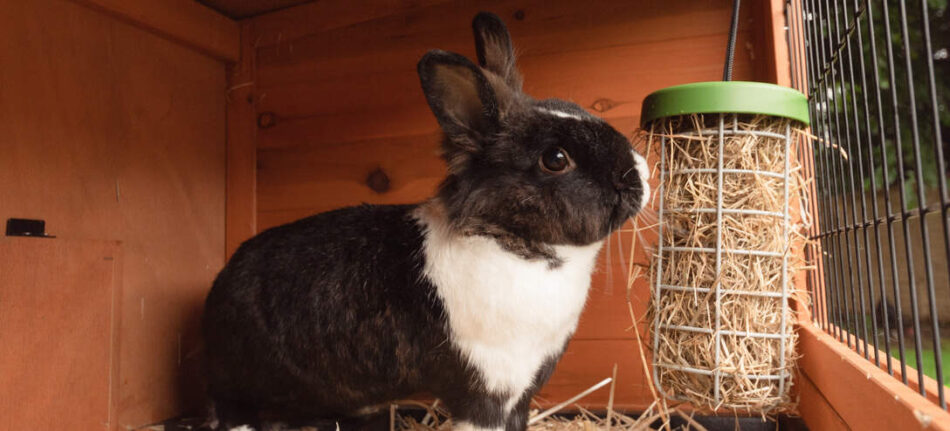
Getting old is part of life. A healthy rabbit will take it in their stride, though, as long as you pay attention to the little details. Staying on top of little red flags will ensure your rabbit will continue to live a happy life.
This entry was posted in Rabbits
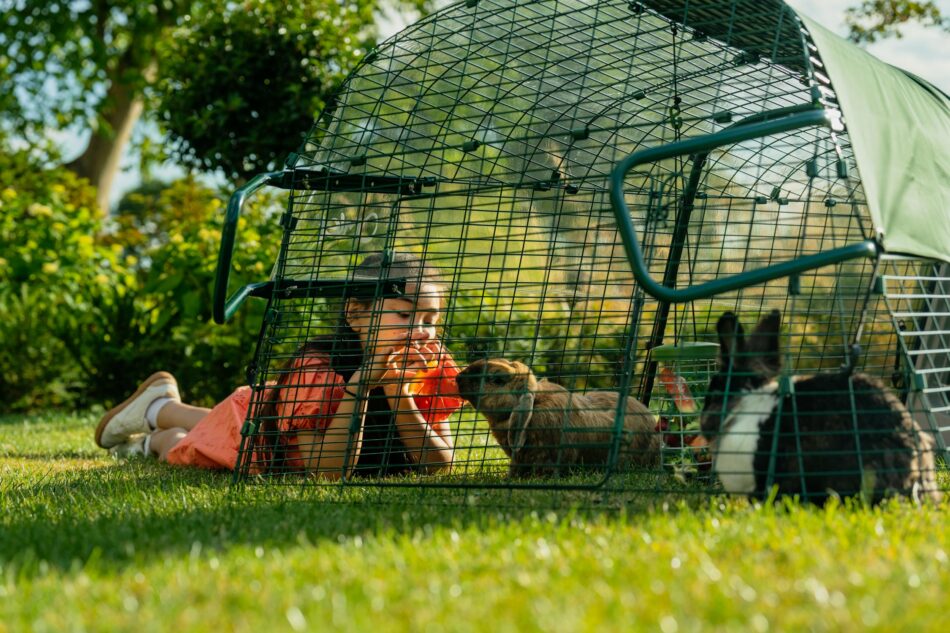 Did you know that rabbits can enjoy a variety of fresh produce? In addition to their dietary staples, bunnies can safely nibble on nutritious garden vegetables and small amounts of fruit. Find out what fresh produce you should be feeding your rabbits, how much, and the benefits of offering them fresh treats.
Did you know that rabbits can enjoy a variety of fresh produce? In addition to their dietary staples, bunnies can safely nibble on nutritious garden vegetables and small amounts of fruit. Find out what fresh produce you should be feeding your rabbits, how much, and the benefits of offering them fresh treats.
What should I feed my bunnies?
First and foremost, rabbits should be fed a quality pellet diet made up mainly of timothy hay. The protein content should fall between 12-16% for most breeds of rabbits, and the fiber content should be at least 15%. Free choice access to loose timothy hay should always be available to help keep their digestion moving smoothly and keep their front teeth trimmed through continuous gnawing. Your rabbits should also have access to fresh, clean water at all times, which thanks to the Eglu Go Rabbit Hutch, is made easy. Simply open the single large door at the back of your rabbits’ enclosure to reveal the bedding tray and access the complimentary hay rack and water bottle.
Anything that’s offered in addition to these dietary staples should be considered treats. Fresh produce is a much healthier alternative to pre-packaged rabbit treats that are commercially available, but should still only be offered a few times a week. Rabbit-safe fruits can also be offered, but in moderation, as they are high in sugar. These foods are not readily available to wild rabbits – and while your domesticated bunnies may have all of their needs provided by you, their digestive system is still very similar to their cousins in the wild. By replicating the diet that rabbits stick to in the wild, you’ll help your pet bunnies maintain a healthy lifestyle.
Rabbit-safe fresh produce
There are several rabbit-safe foods that can be found in grocery stores, home gardens, or even in your own backyard. Fresh produce should be served in a separate feeder than their regular diet to keep their run clean. A hanging treat holder is perfect for serving up fresh foods to keep them away from insects and to give your rabbits a new angle on snacktime.
Some fresh produce is healthier than others, while some should be avoided entirely. This list isn’t comprehensive, but it includes the most common fresh produce that can be offered to rabbits.
Vegetables
Veggies can be offered several times a week, with a few exceptions. Spinach contains oxalic acid, which in high amounts can cause digestive upset in rabbits. Sweet potatoes are also a favorite among bunnies, but are very starchy, so they should be offered sparingly.
Vegetables that are safe and nutritious for rabbits include:
- Asparagus
- Bell pepper
- Broccoli
- Brussel Sprouts
- Cabbage – red, savoy and kale
- Carrot tops (more on carrots later)
- Cauliflower leaves and stalks
- Celery
- Chicory
- Cucumber
- Lettuce – romaine or green leaf
- Parsnip
- Radish
- Spinach (no more than once a week)
- Sweet potatoes (sparingly)
- Turnips
- Watercress
- Zucchini
Carrots – not a rabbit’s best friend
Rabbits are so closely associated with carrots that it’s hard to fathom that they might not actually be that good for them. From Peter Rabbit to Bugs Bunny, fictional rabbits love carrots – and real bunnies love them too. But, carrots are high in sugar and calories, but lack the fiber needed for a rabbit to digest them properly. A carrot-heavy diet can cause constipation in rabbits, and make blood sugar levels rise dangerously. Carrots should be fed as fruits are – fine as an occasional treat, but only offered in moderation.
Fruits
Fruit should be offered in small amounts, no more than 1-2 times per week. Don’t offer fruit to rabbits less than 7 months of age, as their young digestive system may be upset by the sugar content.
Rabbit-friendly fruits include:
- Apples
- Bananas
- Berries – Blueberries, blackberries, raspberries, and strawberries
- Kiwi
- Melon (without the rind) – cantaloupe, watermelon and honeydew
- Pears
- Tomatoes
Herbs and plants
Wild rabbits eat a wide variety of plants, and even wood and bark. There are many forage plants that you can feed your pet rabbits, but not all native fauna is fair game. Never offer a wild plant to your rabbits unless you’re confident in identifying safe types. And, always make sure that wild plants haven’t been sprayed with fertilizers or pesticides – most of which are harmful or even fatal to rabbits.
Herbs and plants that are safe for rabbits include:
- Basil
- Berry leaves – blackberry, raspberry and strawberry
- Clover
- Dandelions – flowers and stems
- Dill
- Grass – fresh stalks, not lawn clippings that may contain other plant matter
- Mint
- Oregano
- Parsley
- Plantain
- Rose – leaves, petals, and stalks
- Rosemary
- Sunflowers
- Yarrow
Dangerous plants and vegetables
Some fresh foods are bad for bunnies. These plants affect your rabbits in many ways, ranging from mild discomfort to being toxic even in small amounts. If you suspect your rabbit has eaten any of the following, keep a close eye on them and call your veterinarian if you notice any unusual behavior.
Never feed your rabbits:
- Aubergines
- Avocados
- Bamboo shoots
- Beans
- Chives
- Garlic
- Iceberg lettuce
- Nuts
- Onion
- Peas
- Potatoes (sweet potatoes are fine)
- Rhubarb
- Tomato leaves (in large quantities)
Feeding your rabbits with Omlet
Finding fresh produce for your rabbits is a fun way to diversify their diet and deepen your bond with them. Offering their fresh foods in a Caddi Rabbit Treat Holder keeps their rabbit hutch and run clean and reduces potential waste. Or, build your bunnies a custom burrow with our Zippi Rabbit Tunnel System and strategically place their snacks along the way. However you choose to treat your pets, we’re here to support your rabbits’ healthy habits.
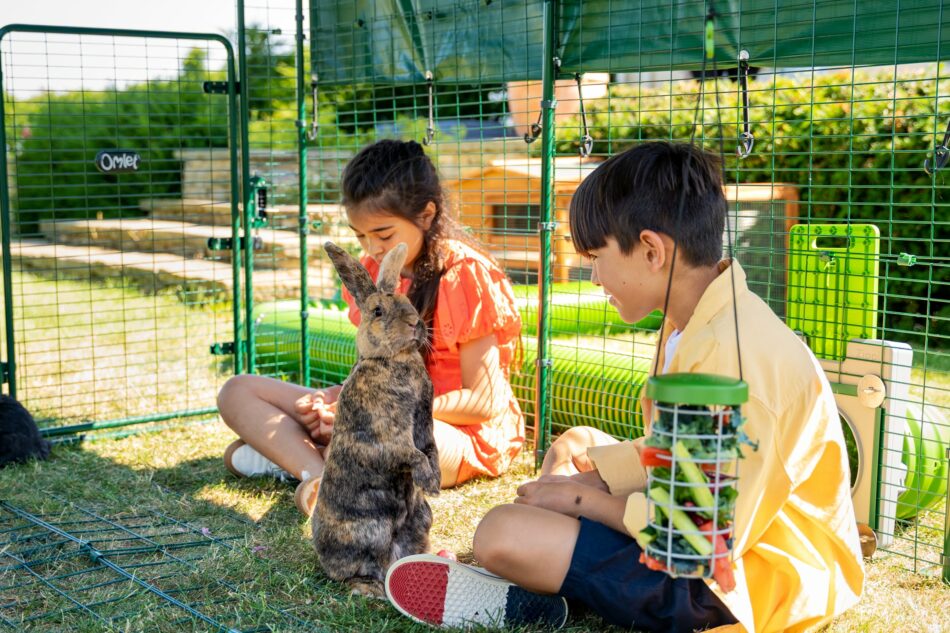
This entry was posted in Rabbits
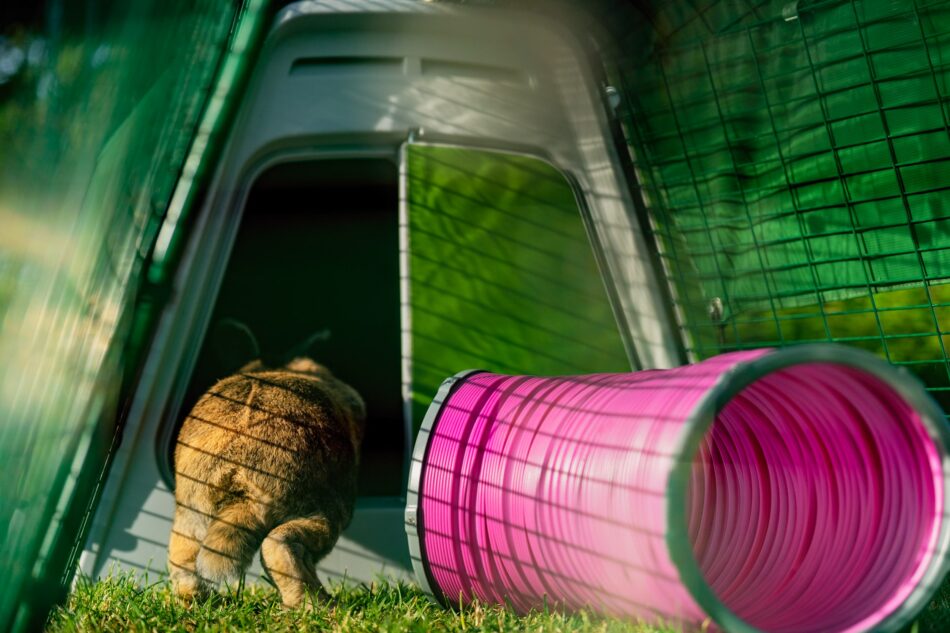
Rabbits make great family pets, and there are many different breeds to choose from. Some are easier to care for than others, making them ideal choices for beginners or children. Other breeds can prove more challenging to care for, but can be enjoyed by more seasoned rabbit-owners. So, which is the best rabbit for you? We’ll outline our top picks.
Children and rabbits
Although they make good pets for kids, rabbits might be disappointing as a first-time pet for young children. This is because most rabbits aren’t fond of being picked up and carried around, and can cause accidental injury to both themselves and children due to their powerful back legs and sharp claws. But, this isn’t to say that rabbits can’t be good pets for children.
Because bunnies need a gentle and practiced hand, it’s best for parents or older siblings to be the ones handling them. Younger children can enjoy sitting with, petting, helping feed, and observing pet rabbits, making rabbits good pets for children of all ages.
5 best rabbit breeds to own
We aren’t trying to play favorites, but there are a few rabbit breeds that stand out as ideal choices for first-time rabbit owners. Their overall personalities, low-maintenance grooming needs, and basic housing requirements make these breeds great options for families.
Mini Lops
Big floppy ears, but with a compact, easy-to-house stature, Mini Lops are a favorite among first-time rabbit owners and breeders alike. They have outgoing personalities, and are known for being good with children. Mini Lops have short-medium coats that don’t require much grooming, and top out between 4.5-6 pounds. They’re easily trained and are social with other rabbits and humans.
Holland Lops
Similar to their cousins, Holland Lops have floppy ears and small bodies. Their faces are more flat than Mini Lops, and their ears are shorter and more rounded. Holland Lops weigh 4 pounds or less when they’re full grown, but have lots of energy. They’re social and enjoy interacting with humans and other rabbits, but need plenty of space to exercise. Because of their energetic nature, Holland Lops prefer to play with their owners rather than be carried around — but they’ll enjoy a good snuggle.
Lionheads
As their name suggests, Lionhead rabbits have tufts of hair encircling their heads that appear like a lion’s mane. While they do have extra hair that requires brushing from time to time, Lionheads have small bodies that weigh between 2.5 and 3.5 pounds when full-grown, making them perfect handling size. In fact, Lionheads are known as “lap rabbits”, and actually enjoy being held and handled. Their sweet, laid-back personalities make them a favorite among families.
Himalayans
Himalayan rabbits have a striking appearance — white bodies with dark points and pink eyes. They grow to be between 3 and 5 pounds, and have short hair that is easy to groom. Himalayans have long been appreciated for their calm and patient personalities. They don’t mind being handled, and are one of the oldest domesticated breeds of rabbits, making them well accustomed to human interaction. Himalayans are easy to train and care for.
Harlequins
A medium breed weighing up to 9 pounds, Harlequin rabbits are stunning in appearance and are curious and outgoing. They love learning tricks, and respond to praise from their owners. Harlequin rabbits should have plenty of space to expend their energy, and thrive off of human interaction. Their size may make them slightly more difficult for children to handle, but their desire to please makes it easy to train them to come when called and accept being petted and held.
Basic bunny care
No matter which breed you choose, all rabbits have the same basic needs. Before bringing your rabbit home, be sure to have:
All rabbit breeds thrive best when they’re given as much space to play and explore as possible. The addition of Zippi Rabbit Tunnels and Zippi Rabbit Playpens broadens your bunnies’ territory and fosters their natural desire to burrow, scurry, and play.
Bunnies need buddies
In addition to their housing, rabbits need companionship. Two neutered males, a neutered male with a female, or two females are all successful combinations. The younger the rabbit, the easier it will be for them to bond with another bunny, but it’s possible to introduce two grown rabbits for a lasting relationship. Rabbits are social animals, and their interactions with each other won’t interfere with the bonds made with their humans.
Consider adopting a bonded pair of rabbits, or obtaining two young rabbits at the same time when starting out. A lonely rabbit may become depressed or act out, so providing your bunny with a buddy will make it easier for you to build a bond with them.
Omlet and your rabbits
Building bonds between you and your bunnies is at the forefront of our designs. Our Eglu Go Rabbit Hutch has everything you and your rabbits need to keep them safe and happy, while our line of Zippi Rabbit Tunnels and Zippi Rabbit Playpens enable you to watch and play with your rabbits in an environment that mimics nature — making your relationship with them as unique as their individual personalities.
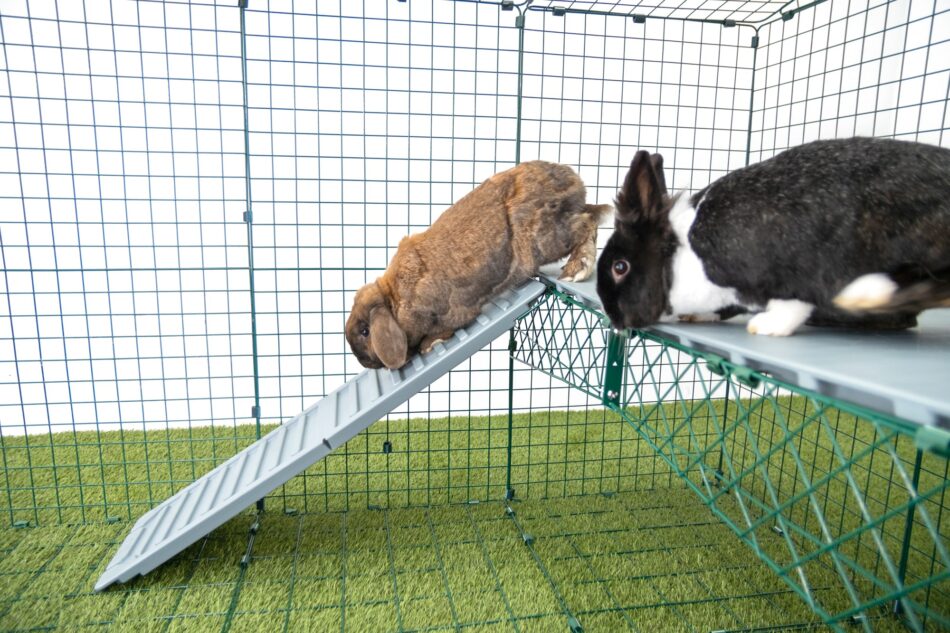
This entry was posted in Rabbits
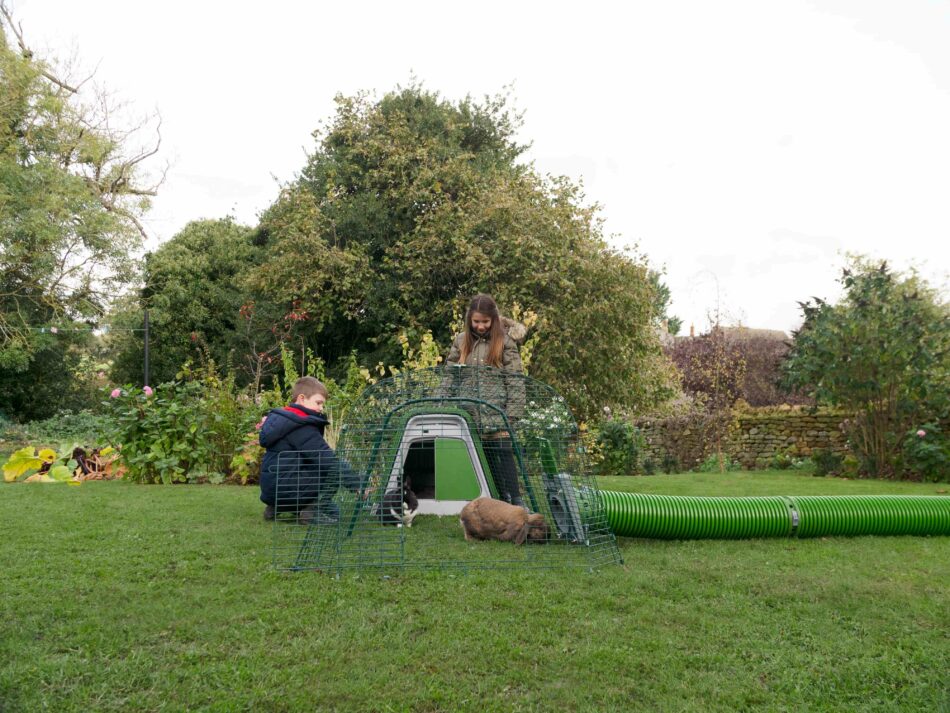 We often get questions about whether rabbits will be okay outside in the winter. The simple answer is: yes. But things get a little more complicated when you consider the specific climate, individual rabbits, and their setups. We’ll share how you can safely keep your outdoor rabbits outside during the winter, and how to determine if and when it’s time to bring them inside.
We often get questions about whether rabbits will be okay outside in the winter. The simple answer is: yes. But things get a little more complicated when you consider the specific climate, individual rabbits, and their setups. We’ll share how you can safely keep your outdoor rabbits outside during the winter, and how to determine if and when it’s time to bring them inside.
Can rabbits live outside during the winter months?
Rabbits that are accustomed to living outdoors are well-equipped to handle the winter months. At this point in the year, you’ve probably noticed your outdoor rabbits’ fur looking mottled due to a process called molting. Molting in rabbits is a natural process that prepares their coats for the winter months ahead, and is triggered by the amount of daylight. So, if your rabbit is outdoors during summer and fall, the dwindling daylight hours signal them to start shedding their thinner summer coat in order to regrow a more dense coat for the winter.
Once they’ve donned their winter coats, your rabbits can withstand the colder outdoor temperatures quite well. In fact, rabbits are much more comfortable in the cold than they are in the heat. But, in order for their natural insulating layers to be effective, bunnies need dry, clean areas to shelter in.
In the wild, rabbits will warm up in underground warrens, or burrows, and huddle together for warmth. Domesticated rabbits need a similar environment – a draft-free, dry hutch to warm up in. The Eglu Go Rabbit Hutch was designed with this in mind. The twin-insulated walls offer protection from drafts while containing the natural body heat of your rabbits within. And, our hutch is designed to provide ample ventilation to prevent moisture buildup, which is especially important during the winter months.
But will they be happier inside?
It may be tempting to bring your outdoor rabbits inside for the winter, but the trouble with this is threefold:
- Bringing your bunnies inside for more than brief visits acclimates them to your home’s interior temperature. This makes it more difficult to move them back outside without shocking their system.
- The artificial lighting in your home will disrupt their biological clock, which may cause them to shed their winter coat too early.
- They will need indoor accommodations away from the hustle and bustle of your home activities. Rabbits may become stressed by stimuli such as televisions, radios, children playing, or other loud noises – especially around the holidays.
Rabbits that are well adjusted to their conditions and schedules outside will thrive much better staying in their home all year round – including during the winter. If your rabbits have lived outside for the rest of the year, save for a couple of caveats.
How cold is too cold for rabbits?
Rabbits don’t adhere to a particular rule when it comes to temperatures. What is true for most bunnies might not apply to others. Observe your bunnies as well as the weather in order to gauge how cold is too cold for your rabbits. If temperatures have been gradually declining over several weeks, your rabbits’ coats should be sufficient to keep them warm enough in even sub-zero temperatures. But, here is where the first caveat of bringing your bunnies inside comes in:
- If the temperatures have been mild for weeks, and your area experiences a sudden and brief cold snap, you may want to consider bringing your rabbit indoors.
This is because a rapid and temporary drop in temperature can be too much for a rabbit that hasn’t finished growing its winter coat. However, the addition of extreme temperature protection on your rabbits’ hutch is enough to bolster your bunnies through a quick cold spell. You can also move your rabbits to a sunnier area of your yard, or under the shelter of a garage or shed in the event of freezing precipitation.
The other caveat to leaving your bunnies outdoors is their health:
- Older rabbits, or those with health conditions that may affect their coats or metabolisms should spend seasons with extreme temperatures indoors.
They don’t have to miss out on all the fun though. Rabbit runs and playpens can be utilized both indoors and outdoors to create safe spaces. On mild winter days, your rabbits will appreciate a romp outside in the sunshine.
What can I do to help my rabbits in winter?
This advice applies if you keep rabbits in an outdoor rabbit hutch and run. If you’re moving your pets inside you won’t have to worry too much about protecting them from bad weather.
Regularly checking in on your rabbits is one of the best ways to ensure they’re in good health, and give you an idea of how well they’re handling the weather. But, there are some other ways you can help your rabbits through the winter.
Exercise
Exercise helps ramp up your rabbits’ metabolisms to help keep them warm during the winter. Make sure they have plenty of space and opportunity to stretch their legs and generate heat. Connecting their hutch to a Zippi Rabbit Playpen via our Zippi Rabbit Tunnel System gives them plenty of room to burrow, explore, and play.
Location
Keep your rabbits’ hutch in a place that receives as much sun during the day. Use clear rabbit run covers during the winter months to allow warming rays of sunshine in for your rabbits to stretch out. If your area receives a lot of snowfall, the addition of wheels and handles to your rabbit hutch allows for quick and easy movement to shelter or shoveled areas.
Bedding
You’ll find your rabbits spending more time in their hutch during the winter due to both decreased daylight hours and temperatures. Make sure to change their bedding frequently to keep them clean and dry. Choose a thick bedding like straw and provide a thick layer for your bunnies to burrow into.
Diet
Your rabbits should have unlimited access to timothy hay all year round, as well as a serving of quality pellets daily. To stoke their metabolisms during the winter, gradually add in alfalfa hay or pellets into their diet to provide extra energy. Other treats like leafy greens can be served in a Caddi Rabbit Treat Holder to keep it up off of the frozen ground.
You’ll also want to switch to a crock or bowl for their water during the winter months to prevent bottles from breaking in freezing temperatures. A bird bath heater or plug-in heated pet water bowl can be used to keep their water thawed – just be sure that the cords are not within your rabbits’ nibbling range.
Your outdoor rabbits with Omlet
Don’t stress over your rabbits during the colder weather. With our Eglu Go Rabbit Hutch, Zippi Rabbit Runs and Playpens, and Zippi Tunnel System, you can create a winter wonderland that both you and your rabbits can enjoy. With dry, insulated dwellings, your bunnies will boldly take on the chilly temperatures – and you will rest assured knowing they’re comfortable and happy not just during this season, but all year round.
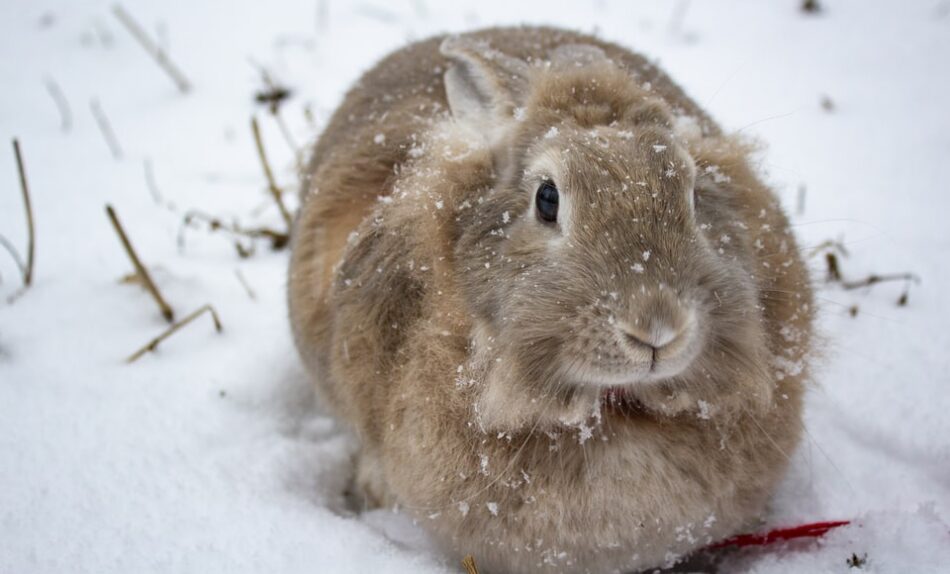
This entry was posted in Rabbits
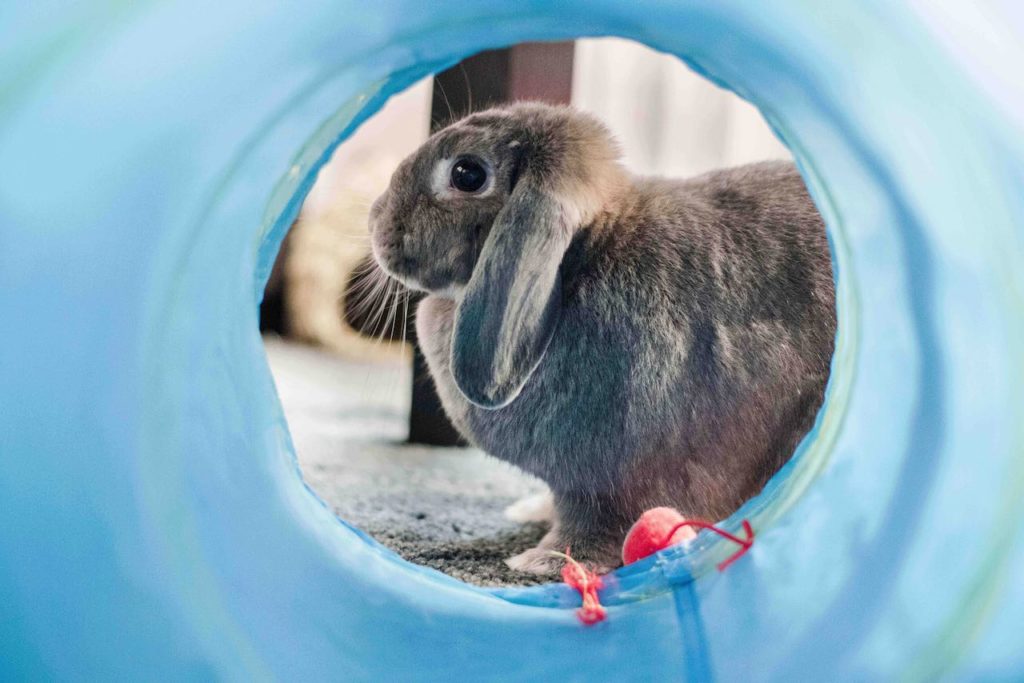
Rabbit owners often ask us if pet bunnies can swim. The answer is yes – but in many ways, it’s the wrong question. If you ask “Do rabbits enjoy swimming?”, the answer is definitely no.
Most mammals are capable of swimming, but not many actually take a dip unless they are forced to. We all know that cats hate water – but they can and will swim for safety if they have to. Rabbits are the same. In times of flood, or if chased by predators, they will sometimes jump in at the deep end and swim for it.
Which brings us to one of many rabbit myths. Bunnies have webbed feet – surely a sign of an animal intended for swimming? Well, no. The webbed feet are there to help rabbits hop and run – not swim.
What about all those swimming bunnies on YouTube?
A quick YouTube search will produce a list of video clips showing bunnies apparently enjoying themselves in swimming pools; but you will struggle to find a clip in which the rabbit voluntarily enters the water. Some can be trained to do so, in the same way as a circus can train animals to do all sorts of things they wouldn’t otherwise choose to do. And that’s the main point – turning your pet rabbit into a circus act is inhumane.
In the various videos of swimming rabbits, the animals don’t appear panicked or distressed. But that’s just the rabbit’s way of surviving. It knows it can float, and it knows it can paddle to safety. It’s not going to thrash around and drown, and nor is it going to give any clues to how it’s feeling in its facial expressions. A rabbit serenely gliding across a garden pool is doing one thing only – surviving.
This has become a contentious issue, and there are even online petitions to prevent swimming bunny videos being posted online. As far as the signatories of the petitions are concerned, this is animal cruelty, nothing more and nothing less.
Healthy Swimming for Rabbits?
There is circumstantial evidence that some rabbits like to float in the water to ease arthritic problems, or simply to clean themselves and/or cool off. The only advice that can be given here – after taking such evidence with a pinch of salt – is to let the rabbit lead the way. A bunny who voluntarily takes a dip does not necessarily need dragging from the water and locking away somewhere dry and safe. The swimming is, no doubt, great exercise, just as it is for humans.
However, the fact that a rabbit enters the water may indicate an underlying problem – perhaps they do, indeed, have joint problems, or maybe their enclosure has an outbreak of fleas, lice or mites, something that might lead a bunny to desperate measures in the backyard pool!
And the fact that it’s a pool presents another potential problem. Pools tend to have chlorine and other chemicals in the water, and these can irritate a rabbit’s eyes, nostrils and skin. Even untreated water can cause skin irritation if a rabbit remains wet for too long. Rabbits have very small lungs, too, and even a small amount of water breathed in by mistake can prove fatal.
If your pet rabbits voluntarily take to the water, dry them thoroughly after they’ve finished exercising. If you’re considering aquatherapy for rabbit joint-related problems, speak to a vet first.
The rule of thumb on this issue is simple – don’t put rabbits into pools or other bodies of water. Yes, they can swim; but no, they don’t like it. Usually!
This entry was posted in Rabbits

















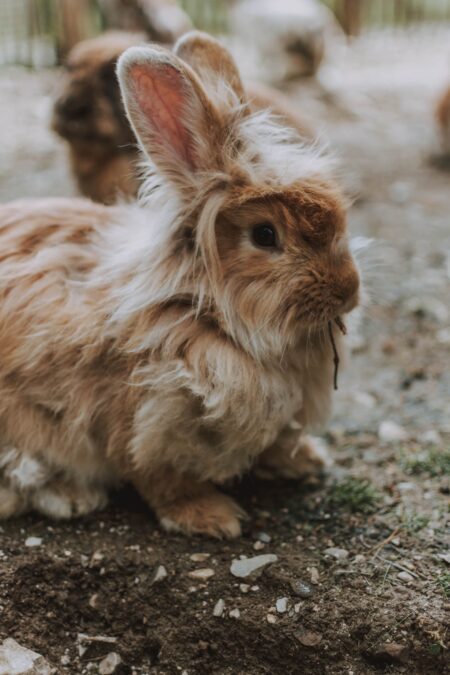
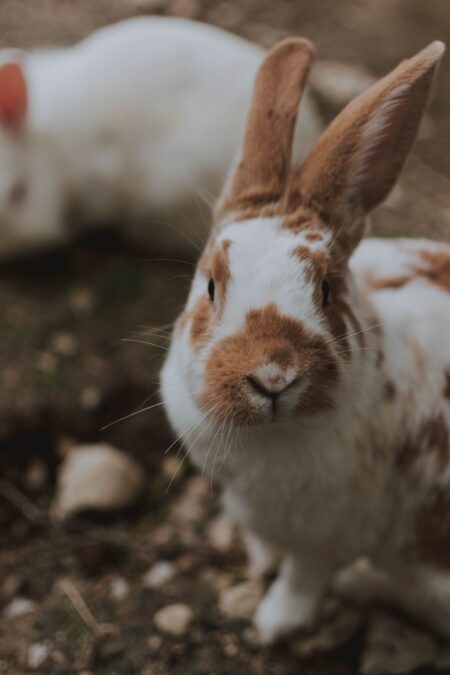










 Thinking she would be a perfect match for Jensen, Wendy took Pixie home. She had divided the rabbit house so that she could slowly introduce them. After about a month, they were lying next to each other, separated only by the wire, so Wendy decided it was time. However, Pixie was traumatized and her fear presented in aggressive behavior. She couldn’t handle it and bit Jensen. She was agitated and frightened of everything. For a while, even putting food down for her was tricky. She would lunge at the hands that fed her. It was a terribly sad time for Wendy to see Pixie so distressed.
Thinking she would be a perfect match for Jensen, Wendy took Pixie home. She had divided the rabbit house so that she could slowly introduce them. After about a month, they were lying next to each other, separated only by the wire, so Wendy decided it was time. However, Pixie was traumatized and her fear presented in aggressive behavior. She couldn’t handle it and bit Jensen. She was agitated and frightened of everything. For a while, even putting food down for her was tricky. She would lunge at the hands that fed her. It was a terribly sad time for Wendy to see Pixie so distressed.


 If you were to meet a species of animal for the first time and had to make an accurate guess about its diet, you would get lots of clues by looking at its teeth. The teeth of a dog, like the teeth of a bear, proclaim loud and clear that this animal is an omnivore – that is, one that eats both meat and vegetables. If you think of your dog as a domesticated wolf, you get a good idea of its natural diet.
If you were to meet a species of animal for the first time and had to make an accurate guess about its diet, you would get lots of clues by looking at its teeth. The teeth of a dog, like the teeth of a bear, proclaim loud and clear that this animal is an omnivore – that is, one that eats both meat and vegetables. If you think of your dog as a domesticated wolf, you get a good idea of its natural diet.
 1. Rabbits
1. Rabbits




